






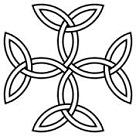

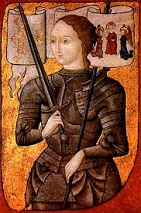










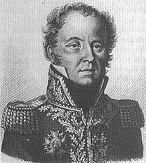





















TLW's Francescope™ (France Historyscope) |
By T.L. Winslow (TLW), the Historyscoper™ |
© Copyright by T.L. Winslow. All Rights Reserved. |
Original Pub. Date: June 27, 2017. Last Update: Oct. 25, 2025. |


Westerners are not only known as history ignoramuses, but double dumbass history ignoramuses when it comes to France's history. Since I'm the one-and-only Historyscoper (tm), let me quickly bring you up to speed before you dive into my Master Historyscope.


Which came first, the chicken or the egg? The Germans just can't get along? In 496 C.E. 30-y.-o. Clovis (Louis) (Chlodwig) (Ludwig) (OG "renowned fighter") I (466-511), pagan king of the Germanic Franks fights the Germanic Alamanni (Alemanni) tribes of Alsace and N Switzerland at the Battle of Tolbiac (Zulpich) in Germany 24 mi. from Cologne, and is almost defeated but rallies and kills their last king and forces them to acknowledge Merovingian sovereignty; after Theodoric, who married Clovis' sister Albofleda intercedes, the Big As are allowed to retain some of their own institutions and manners, and continue living in his domain until 506; Quick, whip out the digital camera? after he either promises his orthodox Christian wife Clothilde that if he wins he will convert to her God, or resorts to invoking the Christian God when the battle is going wrong and is talked into it by Clothilde's confessor St. Remy (Rémy) (Remigius) of Reims (435-533), or is converted by St. Genevieve after she inspires the Parisians to resist him, 30-y.-o. Clovis I is converted to orthodox (Athanasian) (Three-Leaf-Clover) Christianity, then baptized by St. Remy in the Cathedral of Reims on Dec. 25 (after a holy vial is flown down by a white dove?) along with 3K of his subjects, followed by the entire Frankish nation, becoming the first Roman Catholic (orthodox Trinitarian) king of France, founding the Merovingian Dynasty (ends 751); St. Remy utters the baptismal formula: "Bow thy head humbly, Sicambrian, revere what thou hast burned, and burn what thou hast revered"; this all conveniently prevents the Arians, who had pretty much controlled the Gothic arm of the Roman army from finishing off the Athanasians and their priestly nerve center in Rome, the makings of yet another conspiracy theory, esp. when their alleged claims to be descendants of the Jewish Tribe of Benjamin are thrown in? - (Gibbon, Ch. 38) (messing up the French people for 1.5K years? Who did the pope pay off?); unfortunately, his understanding of Christianity is tainted by his savage paganism, and Clovis I comments on the Christ story that "Had I been present at the head of my valiant Franks, I would have revenged his [Christ's] injuries"; "For me, the history of France starts with Clovis, chosen as king of France by the tribe of the Franks, who gave their name to France" (Charles de Gaulle).

In 511 Clovis I dies, leaving four sons, who proceeded to split his kingdom up like a casino, with Theodoric (Theuderic) (Thierry) I (484-534) getting Metz, Rheims, and Austrasia (NE France), Chlodomer (495-524) getting Orleans, Childebert I (497-558) getting Paris, and Chlotar (Clotaire) (the Old) I (497-561) getting Soissons. Ever after, France is plagued by lack of unity, and even when a monarch succeeded in uniting it, the heirs of the other former mini-kings, now calling themselves dukes (an old Roman title), rock the house like John Goodman as King Ralph and combine to keep the king couped up on the tiny tracks-of-my-tears Ile de Paris.
On Oct. 8, 614 (614?) Lothair II promulgates the Edict of Paris, a Frankish Magna Charta that reserves many rights to the Frankish nobles while excluding Jews from all civil employment for the crown and putting all literacy in the kingdom under ecclesiastical control, pleasing the nobles, from whose ranks the bishops are usually drawn.
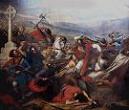
On Oct. 10, 732 Charles Martel "the Hammer" (686-741) becomes the greatest hero in French history when he stops the Muslim Moor takeover of France at the Battle of Tours-Poitier, although it was too late to do anything about their takeover of Spain from the Visigoths in 711, and it takes until 1491 for Catholics Kings Ferdinand and Isabella to finally expel the last of them.

In 743 Pepin III the Short and Carloman finally recognize Childeric III (717-54) (son of Chilperic II?) as Merovingian king of all the Franks (until 751), becoming the last; when Pope Gregory III later seeks his help against the Lombards, he bestows on him the title of "Most Christian", which French kings use ever afterwards.




In 751 Charles Martel's son Pepin III the Short (714-68), mayor of the palace of Paris gets Pope Zachary to agree to let him dethrone the whimpy Merovingian king (since 743) Childeric III, and he is elected the new king of the short, er, Franks (first Carolingian king) at a gathering of Frankish nobles in the Merovingian capital of Soissons, and anointed and crowned at the Abbey of St. Medard, officially deposing Childeric, who is packed off to to the Monastery of Saint-Bertin next year with his son Theuderic (Saint-Omer and Saint-Wandrille?); for the first time bishops attend with a rank equal to secular nobles; annointing with oil superseded the right of blood descent?; he founded his own Carolingian (Carlovingian) Dynasty (House of Pepin) (ends 987), with the remnants of the Merovingians going underground and plotting a comeback (until ?); it has its own Carolingian Cross. Pepin III the Short's giant 7-foot son Charlemagne (742-814) spends his life not only fighting the pesky Muslims in Spain but crushing the remaining pagans in Saxony, Frisia (Netherlands) and Norseland, adopting the Muslim tactic of forced conversion, and building an empire in western and central Europe, for which Pope Leo III crowns him the first Holy Roman Emperor (HRE) on Christmas Day of 800. Too bad, his Sword and Cross technique backfires when the riled-up Norse take to their long ships and become pagan pirate Vikings, terrorizing the Christian coasts at will, and go on to make it their lifestyle for centuries, which cause France and the rest of Europe to go into a defensive under-siege mode called feudalism, see any Road Warrior movie, how many arrests in twenty years, zero point six? Honorable mention should be given to Charlemagne's nephew Roland (-778), who became the subject of endless hero stories.

In 781 Charlemagne's son Louis (Ludwig) I (the Pious) (the Fair) (the Debonaire) (778-840) becomes king of Aquitaine, followed in 813 by HRE, and in 814 by king of the Franks. Too bad, under the weight of Viking raids the Holy Roman Empire becomes kaput by 924, and when it is finally revived in 962 it was German king Otto I the Great who does it, showing how the wheel has turned in 500 years.
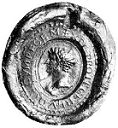
In 817 Louis I the Pious' 3rd son Louis II the German (806-76) becomes king of Bavaria, followed in 843 by the first king of East Francia, which is called Germania by the Romans. Until then the Franks were all probably speaking a mix of fractured Latin and German, but now French began its split from German, if you think Washington is a mess I'm asking you for your vote.
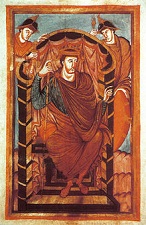

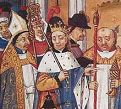
On May 5, 840 as Charlemagne's son HRE Louis I the Pious (b. 778) is returning from battle he sees an eclipse, frightening the superstitious dude to death, and he falls ill on an island in the Rhine near Ingelheim and dies on June 20; he is succeeded by his eldest son (by Ermengarde of Hesbaye) Lothair (Lothar) (Lothaire) I (795-855), whose brothers Pepin II (797-838) of Aquitaine and Louis II the German (806-75) of East Francia, and half-brother (by Judith of Bavaria) Charles II the Bald (Chauve) (823-77) of West Francia start a civil war over succession that lasts until 843 and ends up splitting Charlemagne's Frankish kingdom into three smaller franks (the future France, Germany,
In Aug. 843 HRE Lothair I's brothers Louis II the German and Charles II the Bald force a very done deal family compact on him, the Treaty of Verdun (40 mi. W of Metz, where the Meuse River divides into five branches), which causes him to accept the division of the Carolingian Empire (and all hopes of a resurrected supersized Roman Empire), and lays the foundation for the modern regular-size states of France, Germany, and the Netherlands, creating three Carolingian dynasties that rule Italy (until 875), Germany (until 911), and France (until 987); Lothair keeps the empty title of HRE, remains king of Italy (excluding Benevento) and an amorphous "middle kingdom" of Lorraine (Lotharingia) (Lothringen) bounded by the Scheldt, Upper Meuse, Saone, and Rhone Rivers on the W, and the Rhine River and Frisia on the E, with Aix-la-Chapelle given to him as his capital; Alsace and Friesland are incl. until 870; Louis II the German remains king of the German-speaking East Franks, and receives Saxony, Franconia, and all territory (except Frisia) E from the Rhine; Charles II the Bald remains king of the West Franks, and receives Carolingia, a Romance-speaking territory made up of West Francia and Aquitaine, Gascony, Septimania, etc., approximating medieval France (bounded by the Meuse, Saone and Rhone Rivers, plus the Spanish March as far as the Ebro River); meanwhile Frisia (the Low Countries) comes under Viking control, and the Vikings enter the Mediterranean.
In Feb. 880 the Treaty of Ribemont (near St. Quentin) is signed, and Charles III the Fat cedes W Lorraine to Louis II, fixing the boundary until the 14th cent.
In Mar. 880 after officially dividing their father's realm, Carloman II and Louis III go after Boso I, taking Macon and N Burgundy, then joining up with Charles III the Fat and unsuccessfully sieging Vienne in Aug.-Nov.
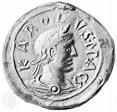
In 881 Louis II the German's youngest son (great-grandson of Charlemagne) Charles III the Fat (839-88) becomes the last Carolingian to rule over Charlemagne's briefly-reunited empire.

In 888 Odo (Eudes) of Paris (859-98), son of Robert the Strong, Count of Anjou becomes the first king of the West Franks, founding the Robertian (Robertine) Dynasty.


The biggest thing to come out of Charlemagne's big mistake was the Normans. In spring 911 after a hundred years of Viking terrorist raids on Free-for-All France, Norse Viking chief Rollo (Hrolf) (Rolf) Ragnvaldsson (the Ganger) (the Walker) (Wend-a-Foot) (860-932) (who once explored the E coast of North Am. as far S as Conn.?) sailed down the Seine River with a raiding and settling party, and sieges Chartres, then prepared to ransack gay Paris, until whimpy king of the West Franks (Charles III, you are no Charlemagne?) Charles III the Simple (879-929) (probably hearing that the Vikings can be bought off, like Eli Wallach in the film "The Magnificent Seven", and saying something like, "Rollo, please do not sack gay Paree, just take this box of treasure, and I'll make you a duke and give you my beautiful daughter, the hottest French poontang in the land, and you can move into the bad side of France and have the left bank of the Seine, plus a little of the right bank, where you can have some Lebensraum and act as bouncers for any other Vikings, how about it, guy"?) cops out, and in the fall signs the Piece, er, Treaty of Saint-Clair-sur-Epte (Fr. "sint clair" = "clear well or pool"), granting them land on the left bank of the Seine River (the bad side of France?), with Rouen (on the right bank) (named after him, which is convenient, because it was originally the Gallic city of Ratumacos) as their new capital, on the condition that they defend the land, receive Christian baptism, and do homage to Charles as their overlord; Charles also sweetens the pot by giving Rollo his daughter (sister?) (all made up?) Gisela of France in marriage to cement the deal; when Rollo's proxy goes to perform the rite of allegiance by kissing the king's foot, the rude Viking stands erect, lifts the royal foot to his mouth and topples Charles over backward, causing Rollo's men to have a good laugh?; Rollo founds the French duchy of Normandy (Northmen Duchy - get it?), becoming duke #1 (until 927), and is baptized under the name Robert, becoming Duke Robert I; the Norsemen acquire the French language and culture (which they proceeded to inject with Norse words and turn into their own dialect), learn to ride horses, build forts and siege machinery, and continue their raids on Brittany; Charles III's act is so unpopular with his barons that they start calling him Charles the Simple, and later depose and imprison him for it. Too bad, after they convert to orthodox Roman Catholic Christanity to keep their side of the bargain, the French teach these newly-PC sea pirates the art of horsemanship, creating the phenomenon of the Norman knights, who become mercenaries and adventurers all over Europe and the Middle East, eventually seizing Sicily (1060-90) and even sacking Rome once (1084), 16 years after taking England from the formerly German Anglo-Saxons, who moved in after the Romans left in the 400s and 500s and pushed the remaining aboriginal Celts back to their usual hiding places in the north and west parts of the British Isles.

On Sept. 20/24, 911 Louis III the Child (b. 893) dies, ending the East Frankish line of the Carolingians; on Nov. 10 to avoid accepting a West Frankish ruler, the German magnates elect Conrad I (890-918), duke of Franconia, who becomes the first elected king of the dying Carolingian Empire (until Dec. 23, 918), fighting Magyar raids and ducal rebellions in Saxony, Bavaria, and Swabia.
 On May 24, 919 Saxon duke (since Nov 30, 912) Henry the Fowler (876-936)
of Saxony is elected king Henry I of East Francia, becoming its first non-Frankish king, founding the Saxon (Ottonian) Dynasty,
a new line of Saxon emperors (ends 1024); he is called the Fowler because the messengers announcing his election find him hawking; cool to the Church, he avoids coronation by ecclesiastics;
by his wife Matilda he fathers three sons, Otto I (the Great) (912-73),
Duke Henry I of Bavaria (919-55),
and Archbishop (St.) Bruno I the Great of Cologne (925-65),
and two daughters, Gerberga (who later marries Louis IV of France), and Hedwig (who later married Duke Hugh the Great and had son Hugh Capet of France) - the original German couch potato?
On May 24, 919 Saxon duke (since Nov 30, 912) Henry the Fowler (876-936)
of Saxony is elected king Henry I of East Francia, becoming its first non-Frankish king, founding the Saxon (Ottonian) Dynasty,
a new line of Saxon emperors (ends 1024); he is called the Fowler because the messengers announcing his election find him hawking; cool to the Church, he avoids coronation by ecclesiastics;
by his wife Matilda he fathers three sons, Otto I (the Great) (912-73),
Duke Henry I of Bavaria (919-55),
and Archbishop (St.) Bruno I the Great of Cologne (925-65),
and two daughters, Gerberga (who later marries Louis IV of France), and Hedwig (who later married Duke Hugh the Great and had son Hugh Capet of France) - the original German couch potato?

On July 2, 936 king (since May 24, 919) Henry I the Fowler of East Francia died, and his son Otto I (the Great) (912-73) is crowned king of Germany in Aachen by the archbishop of Mainz, his coronation banquet reviving the Carolingian tradition (based on the Roman tradition), with the duke of Franconia serving as ceremonial steward, the duke of Swabia as cupbearer, the duke of Lorraine as chamberlain, and the duke of Bavaria as marshal; he establishes Quedlinburg in Germany as his seat; beginning of the Ottonian Period in Architecture (ends 1050); Otto begins a 3-year war to reduce the duchies of Bavaria, Franconia, Lorraine, and Saxony, and later kept all of them except Saxony in his own hands or those of his family; on Feb. 2, 962 he is crowned HRE (until May 7, 973) - but this is getting off the main track, so we'll return to Frankenberry.
In 908 Fulk I the Red (le Roux) (870-942) becomes the first count of Anjou, France (until 942).
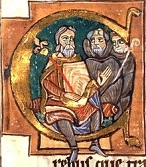
 On Apr. 30, 909 William I "the Pious", Duke of Aquitaine, Count of Auvergne (875-918)
founds the Benedictine Cluny (Gael. "from the meadow") Abbey in Burgundy, France on the site of his hunting lodge, consecrated
to St. Peter and St. Paul, led by abbot #1 (until 925) (St.) Berno of Baume (850-927) under direct papal jurisdiction, but with
the pope's hands tied with respect to the power of transferring title or appointing an abbot without the consent of the monks, going on to become the #1 monastery in Europe within a cent. by
benefitting from the lack of oversight from anarchic Rome, choosing abbots of high social backgrounds, and allowing affiliates to accept royal patrons, with the abbots becoming internat. statesmen,
reaching its max influence from the mid-10th cent. through the 12th cent.; the first female members were admitted in the 11th cent.;
Berno institutes the Benedictine Cluniac Reforms; for awhile the duke forgets to remove his hunting dogs to make room for the monks.
On Apr. 30, 909 William I "the Pious", Duke of Aquitaine, Count of Auvergne (875-918)
founds the Benedictine Cluny (Gael. "from the meadow") Abbey in Burgundy, France on the site of his hunting lodge, consecrated
to St. Peter and St. Paul, led by abbot #1 (until 925) (St.) Berno of Baume (850-927) under direct papal jurisdiction, but with
the pope's hands tied with respect to the power of transferring title or appointing an abbot without the consent of the monks, going on to become the #1 monastery in Europe within a cent. by
benefitting from the lack of oversight from anarchic Rome, choosing abbots of high social backgrounds, and allowing affiliates to accept royal patrons, with the abbots becoming internat. statesmen,
reaching its max influence from the mid-10th cent. through the 12th cent.; the first female members were admitted in the 11th cent.;
Berno institutes the Benedictine Cluniac Reforms; for awhile the duke forgets to remove his hunting dogs to make room for the monks.
On June 22, 910 Duke Gebhard of Lotharingia (b. 888) is KIA near Augsburg in a battle against the Magyars, and his son Reginar I Longneck (850-915) becomes duke #2 of Lorraine in NE France (until 915).




Lucky for France and the rest of Europe, the Muslims split into the warring Shiite and Sunni camps, who started hating each other worse than the Christians, taking the steam out of their formerly relentless plan to conquer the world for Allah. Meanwhile by the end of the 900s the Viking menace began ending as the big voodoo date 1000 scared them into finally converting to Christianity, after which the promised Armageddon and return of Christ failed to materialize, but tough titties, it was too late to go back, since once a child is brought up Christian the Church has their mind for life by age 5, right? (Ditto any religion, unfortunately.) In 987 after new king Louis V (b. 967) died one year after his accession from a hunting accident (or was poisoned by his mother), leaving no heirs, Bishop Adalbert of Reims and Gerbert of Reims engineer the election of Hugh Capet (938-96), who founds the Capetian Dynasty (until 1328), which becomes known for long-reigning weak kings (other than his measly 9 years), Edward Gibbon writing the famous soundbyte about them: "In this narrow compass [Paris and Orleans] he was possessed of wealth and jurisdiction; but in the rest of France, Hugh [Capet] and his descendants were no more than the feudal lords of about sixty dukes and counts, of independent and hereditary power... whose disregard of their sovereign was revenged by the disobedience of their inferior vassals" - (The Decline and Fall of the Roman Empire, Ch. 58). He is followed by Robert II the Pious (972-1031) (35 years), Henri I (1008-60) (pronounced like "on ree") (29 years), and Philip (Philippe) I the Amorous (1052-1108) (from the Greek word for horse-lover) (48 years).


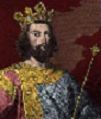
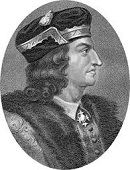

In 1108 Louis VI the Fat (1081-1137) becomes the first Capetian king who was popular with the people of France, enjoying a well-fed 29-year reign. His son Louis VII the Young (1120-80) (43 years) was also popular, his first wife (1137) being Eleanor of Aquitaine (1122-1204), who later (1152) marries Henry II of England, making Henry a big man in France as well as England in one of the biggest power plays of the 12th cent., starting the 300-year tug-of-war ending with the Hundred Years' War (1337-1453). Philip (Philippe) ("horse lover") II Augustus (1166-1223) (43 years) goes on the Third Crusade with his pal Richard I Lionheart of England, then turns into bitter enemies, and Philip gets Richard captured on his way back and held for ransom, while Richard's mean bro' John Lackland schemes to stab him in the back, see any Robin Hood flick. After seeing both of Henry II's sons Richard I and John I come to bad ends, and boy king Henry III placed on the English throne, Philip II dies as the #1 monarch of Europe. Too bad, his son Louis VIII the Lion (1187-1226) breaks the mold and ruins all his work with a short 3-year reign ended abruptly by dysentery contracted during a campaign to burn Albigensian Cathar heretics in Provence (south France).
In 1198 deciding he likes the way they pay taxes on their usury, Philip II Augustus readmits the Jews to France, and heavily regulates and taxes their banking activities; meanwhile new Pope Innocent III excommunicates him for rejecting his lawful 2nd wife (since Aug. 15, 1193) Ingeburga (Ingebiorga) (Ingeborg) of Denmark (1174-1230) in place of hotter 3rd wife (since June 1196) Agnes of Meran (-1201), daughter of the duke of Meran; his first wife (1180) was Isabella of Hainault, who died in 1190.
On Jan. 15, 1208 a knight working for Count (since 1194) Raymond VI of Toulouse (1156-1222) kills papal legate Pierre de Castelnau, and Pope Innocent III deposes him for it; the pesky Byzantine heretics seemingly in hand, Pope Innocent III first vainly appeals to Philip II of France, who refuses to get involved, then proclaims a Crusade against #2 on his list, the Cathars (Albigensians) (Catharists of Albi) ("the Western Buddhists"), a group of sects of too loose heretical dualistic vegetarians in S (Provencal) France centered in Toulouse, which started out as a reaction against clerical corruption but was joined by the nobles as a way to appropriate Church lands, becoming fabulously wealthy and getting mixed-up with the Templars; believing that Crist was a prophet of Amor (love), they refuse to make a big deal of the Crucifixion, which they regard as an emblem of Rex Mundi (Lord of the Material World), which has twisted Amor into its opposite, Roma, also denying the sacraments of Baptism and Communion, and practicing birth control and abortion, accepting reincarnation and the female principle, allowing women parfaits (priests), and insisting on direct personal contact with God rather than mere faith; looking for a get-out-of-purgatory-free card, Duke Eudes III of Burgundy steps up to the plate and organizes a campaign against the Cathar strongholds in Languedoc next year, starting the Albigensian Crusade (ends 1229).

On May 6, 1211 after the original 5th cent. church burned down last May 6, the new High Gothic Notre-Dame de Reims (Our Lady of Reims) Cathedral in Reims (Rheims), France is begun by architects Jean d'Orbais (1175-1231) (master architect), Jean-le-Loup (who replaces Jean d'Orbais in 1231-47 or 1235-51), Bernard de Soissons (1255-90 or 1259-94), and Gaucher de Reims (1247-55 or 1251-9), complete with 3-tier elevation and qudripartite vaults; it is finished in 1275, with the upper facade taking until 1311.
In June 1212 the Children's Crusade in France (poor people not children?) is preached by big-mouthed boys Stephan (Stephen) of Cloyes (b. 1200) and Nicholas of Cologne (b. 1202); too bad, it fizzles when Stephan's crowd is sold into slavery or returns home after reaching Marseilles, while Nicholas' contingent allegedly reaches as far as Pisa and the Papal States before being turned back; the origin of the legend of the Pied Piper? In the summer King John oversees the hanging of 28 sons of Welsh princes and lords who were being held hostage for their fathers' good behavior, incl. one less than 7 years old.
On May 20, 1217 Prince Louis the Lion (future Louis VIII) is defeated at the Second Battle of Lincoln (first in 1141) by a relief force under William Marshal; the Comte de la Perche is KIA, and Robert Fitzwalter is captured, after which the French sack the city of Lincoln, causing it to be called "Lincoln Fair"; meanwhile as much as the English hated John, now that he's gone they begin to react against Louis (because, according to Shakespeare in King John, 5.4.15-16, "Lewis means to recompense the pains you take/ By cutting off your heads"?).
On Aug. 24, 1217 the naval Battle of Sandwich is V for the English navy under Hubert de Burgh over the French navy under Eustace the Monk, who is KIA.
On Sept. 11, 1217 after most of the rebel baron turn on Prince Louis the Lion, the Treaty of Lambeth (Kingston) is signed, and Louis agrees that he has never been the legitimate king of England; the French leave England and free Fitzwalter, ending the First Barons' Revolt (begun 1215); Henry III is acknowledged undisputed king of England, but the pope really rules it through his legate Guala (Gualo); the Charter of the Forest is agreed to by Henry III as a supplement to the Magna Charta, providing for the right of common access to royal forests for fuel, and abolishing the death penalty and mutilation as punishments for taking royal game, going on to become the longest-lasting statute in England until superseded on July 1, 1971 by the Wild Creatures and Forest Laws Act.
On June 25, 1218 after the defenders of Toulouse, France construct a trebuchet, and the Crusaders construct a cat (mobile shelter), which is destroyed by the trebuchet, Provencal-killer Simon IV de Montfort (b. 1160) is KIA by a siege engine operated by women, and Raymond VI regains his position as count of Toulouse.

On July 6, 1218 Eudes III (b. 1166) dies, and his eldest son Hugh IV (1213-72) becomes duke of Burgundy, France (until 1271), going on to expand his duchy to incl. the counties of Chalon and Auxonne.
In 1218 Duke Peter I de Dreux of Brittany is finally recognized as earl of Richmond by William Marshal, regent for young Henry III, although Yorkshire remains in control of the earl of Chester; the increased revenue emboldens him to demand the same privileges from his nobles as the other dukes of France have, causing a minor civil war (ends 1223).
On Mar. 7, 1219 Pope Honorius III approves the religious congregation of Val des Ecoliers (Valley of the Scholars) at the U. of Paris.
On June 3, 1219 after Philip II's hittin'-the-gym-every-day son Prince Louis da Lion (later Louis VIII) of France fights against the Albigenses in S France, he directs the brutal massacre of 5K townspeople in Marmande - I'll take my toast with marmalade?

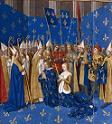
On July 14, 1223 French king (since Sept. 18, 1180) Philip II Augustus (b. 1180) dies, leaving a legacy as the #1 Euro monarch of the day, with his well-embellished and well-walled Paris as the undisputed cultural capital of W Europe, and on Aug. 6 his 36-y.-o. son Louis VIII the Lion (Coeur de Lion) (1187-1226) is crowned Capetian king #8 of France in Reims (until Nov. 8, 1226), becoming the first Capetian king not crowned in his daddy's lifetime; too bad, he breaks the mold a 2nd time with a pathetically short reign.
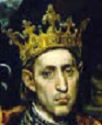

On Jan. 30, 1226 Pope Honorius III approves the mendicant Carmelite Order (founded in 1224), and induces French king Louis VIII (b. 1187) to crusade against the remaining Albigenses, and he conquers Avignon in Provence, then most of Languedoc, starting the practice of bestowing huge fiefs as appanages on princes of the blood, which later backfires in Burgundy and elsewhere; he then dies on Nov. 8 of dysentery on his return to Paris, and his able, carefully-educated Capetian son Louis IX (the Saint) (1214-70) (canonized in 1297) (the ideal medieval king?) succeeds him as Capetian king #9 (until Aug. 25, 1270), with his mother Blanche of Castile (1188-1252) as regent, going on to continue his daddy's policy of enlarging the French royal domain and getting brownie points with the Church by kicking any remaining Albigensian butt around the Mediterranean, and introducing the title of admiral into France while winning a rep. for justice which makes him the arbiter of Europe, and his reign the golden age of medieval France; in the meantime his devout mouther, er, mother gets the support of the people, officials, and Church to suppress a number of feudal rebellions (1226-31) while he finished growing up, wearing the saint-making itchy-scratchy goat-hair shirt.
On Apr. 12, 1229 Raymond VII of Toulouse surrenders to 17-y.-o. Louis IX and his regent mother Blanche of Castile, and signs the Treaty of Paris (Meaux), ending the Albigensian Crusade (begun 1209), betrothing his heiress to Louis' brother Alphonse, while Louis IX is betrothed to Margaret of Provence (1221-95), marrying her on May 27, 1234, proceeding to steal Provence from the HRE; Raymond VII cedes over half of his territory to the king, retaining the remainder only during his life and agreeing to dismantle his fortifications in Toulouse et al., causing Occitan political autonomy to be kaput, and Cathars to lose their last political protection, with Raymond required to hunt them down as vassals of the king.

About 1230 French poet Guillaume de Loris (1200-40) composes the 4,058-line romantic courtly love poem Roman de la Rose (The Romance of the Rose), about the attempts of a courtier to woo his beloved in a walled garden (locus amoenus); in 1275 French poet Jean de Meun (Meung) (Jean Clopinel or Chopinel) (1240-1305) composes 17,724 more lines; it becomes the most-read book in Europe through the 15th cent. after Chaucer translates it into English in the late 14th cent.
In 1233 in his bulls of Apr. 13, 20, and 22, in order to combat the Albigenses in France, Pope Gregory IX founds the Monastic Inquisition, and appoints the Dominicans as the official Inquisitors for all dioceses of France; the smoke-choked Burning Times in France begin; James I the Conqueror of Aragon, champion of the Catalan language stinks himself up by inviting the Inquisition into his realm to stop the Albigensian troubadours finding refuge from S France in Aragon and Catalonia from making a vernacular trans. of the Bible - ah, ah, I need some help here?
In 1234 Louis IX (b. 1214) declares himself of age and assumes personal rule.

In 1234 after Rabbi Solomon ben Abraham of Montpellier in S France gets antsy about all the Roman Catholic attacks on the Albigensian heretics, and doesn't want his congregation to be next, he anathematizes the philosophical works of Jewish brain man Maimonides (1135-1204), excommunicating all Jews who treat the Bible allegorically or even study science or profane lit.; Maimonides' supporters led by David Kimchi (Kimhi) (Qimhi) (1160-1235) (AKA Radak) and Jacob ben Machir ibn Tibbon (1236-1304) (AKA Prophatius) strike back by persuading the Jewish congregations of Beziers, Lunel, and Narbonne in Provence, and Sargossa and Lerida in Spain to excommunicate Solomon and his followers; Solomon counterattacks by denouncing Maimonides to the Dominican Inquisition in Montpellier, causing them to burn all his works there, followed by Paris in 1242, setting a precedent that makes books too hot to handle in Roman Catholic lands; too bad, 40 days later they burn the Talmud in Paris too; knowing that if you can get away with books, why not people, on June 13 Pope Gregory IX pub. the 5-vol. Liber Extra (Decretals of Gregory IX), a collection of 2K decretals which he has sent to the univs. of Bologna and Paris, repeating St. Augustine's belief that "every pagan, Jew, heretic, and schismatic will go to the eternal fire prepared for the Devil and his demons", giving the force of canonical law to the doctrine of perpetual servitude of the Jews until Judgment Day, banning them from direct influence over the political process and the life of Christian states until the 19th cent. rise of liberalism; it contains the oldest surviving detailed Description of a Diabolical (Witches') Sabbath, describing the novice having to kiss an enormous toad, then a cold, pale, thin man, which causes him to forget the Catholic faith, then, after a feast, having to kiss a black cat, then the head devil (or devil's head), and finally participate in an orgy; Pope Boniface VIII adds a 6th book in 1298 (dominica, nica, what?); meanwhile the Jewish war over Maimonides continues, with Maimonides' followers getting Solomon ben Abraham executed for ratting on fellow Jews, and his leading followers' tongues cut out; meanwhile a rabbinical ban on study of science is issued by Rabbi Don Astruc of Lunel (Abba Mari ben Moses ben Joseph) (Yarhi), supported by Rabbi Asher (Asheri) ben Yehiel (Jehiel) (1250-1327) (AKA Rabbenu Asher, Rosh) and Nacmanides (1194-1270) (AKA Ramban), causing his student Rabbi Solomon (Shlomo) ben Abraham ben Aderet (1235-1310) (AKA Rashba) of Barcelona to do ditto in 1305 for teaching any science, or studying it before age 25, except medicine, causing the rabbis of Montpellier to threaten to excommunicate any Jew who stops his son from studying science; the net result is the decline of science study in the Euro Jewish community, and a retreat into mysticism, esp. the Qabala - I got Scrombosis, I'm dead from the neck up?
In May 1239 Pope Gregory IX sends his bushy-tailed Inquisitors (fresh from Inquisitor Training School in Hell?) to burn the entire town of Champagne, France, along with all 180 citizens.
In 1239 Pope Gregory IX orders the confiscation of all copies of the Talmud, which is generally ignored except in France, causing Jew-hating French Capetian king (1226-70) (St.) Louis IX (1214-70) to call for a public debate first, which is held in 1240.
In 1239 Emperor Baldwin II presents Jesus' alleged Crown of Thorns worn on the cross to Louis IX, who has it stored in Notre Dame Cathedral in Paris; it is briefly removed during the French Rev., and returned in 1806.
In 1242 Aquitaine submits to Louis IX.
On Apr. 27, 1243 the 5-year Treaty of Bordeaux is signed by Henry III of England and Louis IX of France, ending the Saintonge War (begun 1242), preserving the territorial status quo after Louis IX decides not to annex Guyenne, pointing to his desire to go on crusade, becoming the last major English-French conflict until the 1294-1303 Anglo-French War and pissing-off the English barons with Henry III's incompetence in war and tyrannical ways in defiance of the Magna Carta, leading to the Second Barons' War in 1264-7.
In May 1243 10K Roman Catholic troops of the seneschal of Carcassone and the archbishop of Narbonne in France surround and siege the impregnable Cathar fortress of Montsegur (Montségur) (W of Rennes-le-Chateau in Languedoc) (until Mar. 16, 1244); since the fabulously wealthy Cathar parfaits (priests) are not permitted to bear arms, the fortress is defended by mercenaries.
The French Masada? In Jan. 1244 two Cathar parfaits escape the encirclement carrying the fabled Cathar treasure, which is not heard of again (until ?); on Mar. 1 impregnable Montsegur Castle in France on the slopes of the Pyrenees overlooking the Plain of Languedoc is captured after a 10-mo. siege, and the occupants are offered lenient terms incl. departing with their personal property intact if they abjure the Cathar faith, and the 400 defenders request a 2-week truce to consider it, offering hostages as insurance; on Mar. 15 one day after their sacred festival of Bema (which falls on the spring equinox this year) all 215 Cathar parfaits (incl. 20 - 15 mercenaries and six women, who become parfaits at the last minute) refuse to abjure their faith, and are burned in an enormous fire at the Prat des Cramats near the S foot of the castle in a wood-filled stockade, with the rest forced to watch; on Mar. 16 (night) four parfaits concealed by the others escape down the W face of the mountain on ropes, carrying away some other Cathar treasure that was needed for Bema, taking it to the fortified caves of Ornolac in the Ariege, where a band of Cathars is soon killed sans the treasure, which went to Rennes-le-Chateau?; Catharism is driven underground; it later resurfaces as the Waldensians, Hussites, Adamites (Brethren of the Free Spirit), Anabaptists, and Camisards?
On Dec. 5, 1244 Margaret of Constantinople (1202-80) inherits Flanders and Hainaut, and designates her eldest son by her 2nd husband William III of Dampierre (1224-51), William of Flanders (-1251) as her heir, launching the War of the Succession of Flanders and Hainault (ends 1246) between him and her other son (half-brother) John I of Avesnes (1218-57).
In 1247 Carcassonne in S France is joined to the French crown.
In 1250 Notre Dame Cathedral in Paris, France (begun in 1163) is finished.
In 1251 thousands of shepherds (pastoreaux) lead the popular Pastoureaux (Shepherds) Insurrection (Crusade) in N France allegedly to rescue Louis IX, intending to usher in the Parousia by slaughtering "heretics", i.e., Jews, Muslims, intellectuals, and the rich.
On Apr. 30, 1252 St. Louis IX of France is released after paying a princely ransom of 500K pounds tournois (50K gold bezants - the entire annual revenue of France), moving his army to Jaffa to regroup, throwing a chess set overboard on his trip from Egypt, making John of Ibelin, count of Jaffa into a big man who corresponds with Henry III of England, and Pope Innocent IV; meanwhile Louis IX goes on a pilgrimage to Jerusalem (ends 1254) - it's nice to be a rich saint?
On May 11, 1258 the 1258 Treaty of Corbeil settles the claims between Louis IX of France and James I of Aragon to France's advantage, relinquishing all French claims to Barcelona and Roussillon in return for part of Provence and Languedoc, with both sides giving up the idea of cross-Pyrenees kingdoms; Louis IX's son Philip is betrothed to Isabella of Aragon.
On Dec. 4, 1259 the Treaty of Paris between France and England yields Perigord and the Limousin in S France to Henry III of England, despite protests from both provinces, in return for renunciation of English claims to Normandy, Maine, Touraine, and Anjou; Guienne becomes distinct from Aquitaine; Navarre is cut off from the sea; despite the peaceful intentions of Louis IX, public opinion goes against him, weakening his position in S France.
In 1259 Pope Alexander IV summons U. of Paris brain man Thomas Aquinas to Rome (until 1268), where he wows everybody with his erudition.
In 1265 Louis IX permits his younger brother Charles of Anjou to accept the crown of Sicily, dragging France into Italian problems, starting with newly-minted Charles I of Anjou (Naples) (1226-85) coming with a large army to Rome - to scope out his future new capital?
In 1269 Louis IX founds the Order of the Ship and the Double Crescent (Sea Shell) for nobles who accompanied him on his ill-fated Seventh Crusade.
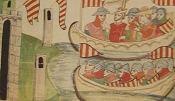

On July 27, 1276 after falling ill in Alzira and resigning with the intention of retiring to the Monastery of Poblet, king (since Sept. 12, 1213) James I the Conqueror of Aragon (b. 1208) dies in Alzira, Valencia, and his eldest son Peter III (1239-85) becomes king of Aragon and Valencia and count of Barcelona (until Nov. 11, 1285), while his 2nd son James II the Just (1267-1327) signs the Treaty of Perpignan (capital of Roussillon), becoming king of Majorca, Ibiza, and Formentera, count of Roussillon and Cerdanya, and lord of Montpellier as a vassal of Aragon (until 1311), which doesn't set well with him since he has the larger domain, causing him to get in a constant battle with his big brother and end up allying with the king of France against him; meanwhile the Muslims, seeing their chance begin a revolt in Valencia (ends 1280); the Kingdom of Labia, er, Majorca is founded (until 1349).
In 1281 20 years after setting out from Yuan China on a pilgrimage to Jerusalem, only to get holed-up in Baghdad instead, where they are welcomed by Nestorian patriarch Denha I, Turkish Chinese monk Rabban Bar Sauma (Sawma) (1220-94) and his student Rabban Markos return to Maragheh after Markos is elected Yaballaha III, patriarch of the Nestorian Church, and in 1278 he sends his former teacher to Rome to negotiate an entente between the Nestorian and Roman Catholic churches and form a strategic Franco-Mongol alliance against the Muslim Mamluk sultanate in Cairo, arriving after the death of Pope Honorius IV and negotiating with the cardinals instead, proceeding to Genoa then Paris, where he spends 1 mo. with Philip IV the Fair, then to Gascony, where he meets Edward I of England in Bordeaux, who is enthusiastic but begs off due to conflicts with the Scots and Welsh; he then returns to Rome, where new Pope Nicholas IV gives him communion on Palm Sun., 1288 before returning to Baghdad; Bar Sauma writes an account of his travels giving the viewpoint of the East on the West, beating Marco Polo.
On Mar. 30, 1282 (Easter Mon.) at the hour of Vespers near a church outside Palermo the War of the Sicilian Vespers (ends 1302) breaks out when 2K men, women and children, incl. nearly all the French in Sicily are massacred, causing the Sicilians to expel all the French and offer their throne to Peter III of Aragon, who is connected by marriage to the house of Hohenstaufen, and Aragon assumes rule of the kingdom of the Two Sicilies (until 1285); Philip III the Bold of France then leads a crusade against him as champion of Pope Martin IV, and a cent.-long war begins over Sicily between the Angevin kings of Naples and the Aragonese kings of Sicily (until 1442), with Sicilian independence secured at the cost of ruining the economy; meanwhile the old anti-French papal policy is resumed.

The original I'm too sexy for my shirt takes over the French quatre-walk? On Oct. 5, 1285 French king (since Aug. 25, 1270) Philip III (b. 1245) dies in Perpignan after getting sick on his return home, claiming on his deathbed that his conquests were in the name of his family and not against the Church; his handsome recently-married teenie son Philip IV (Quatre) (the Fair) (the Handsome) (Le Bel) (1268-1314) (known for his long blonde hair) becomes Capetian king #11 of France (until 1314), ruling as a "constitutional king", letting himself be bound by law and precedent while trying to extend royal authority as far as possible, which means destroying the feudal system, while he cultivates an aloof image, causing people to call him a "useless owl"; "He is neither man nor beast, he is a statue" (Bishop Bernard Saisset of Pamiers).
In 1288 Philip IV begins a battle with the bishop of Poitiers and the cathedral chapter of Chartres (ends 1290), winning an acknowledgement of the principles of royal temporal jurisdiction throughout his realm, and that clerical privileges are guaranteed by the king not the pope.
In 1288 after complaints over taxes, Philip IV of France tightens his control over Flanders.
In 1288 under Philip IV the first mass-burning of Jews on the stake takes place in France.
In 1289 Pope Nicholas IV issues a bull combining several schools dating back 100+ years into the U. of Montpellier in Montpellier, France on the Lez River 31 mi. SW of Nimes, with the school of medicine starting out on the wrong foot by claiming that the Black Death is caused by a miasma entering open body pores, arguing against bathing; in 1529 it expels student Nostradamus for having worked as an apothecary; alumni later incl. Rabelais and Paul Joseph Barthez; in 1593 it founds the Jardin des Plantes de Montpellier, the first botanical garden in France.
In 1289 letters containing block printing are sent from Persia to the king of France, going on to be developed in Ravenna.
Late in the 13th cent. the Rondeaux form of poetry originates in France, becoming one of the three formes fixes of French verse along with the Ballade and the Virelai, going on to be used until the 15th cent.; a virelai with only one stanza is called a Bergerette.
In the 14th cent. Jongleurs (prof. musical entertainers) blossom in France.
In the 14th cent. the Rondel verse form originates in France, spreading to England and Romania, a variation of the rondeau consisting of two quatrains followed by a quintet (13 lines total) or sestet (14 lines total), of the form ABba abAB abbA(B).
In the 14th cent. Benedictine monk Sidone Benoit (Benoît) of the Abbaye-aux-Hommes in Caen in the Calvados dept. in Basse-Normandie, France invents the dish Tripes à la mode de Caen by adding apple cider and apple brandy to bland tasteless tripe - the French taste the forbidden apple and sell their souls to the Devil forever?
In Jan. 1300 after invading Flanders last year, the French capture Count Guy of Flanders (1226-1305) and his son Robert of Bethune (Béthune) (1249-1322); Guy is released in 1302 to negotiate terms after the French V at the Battle of the Golden Spurs, and imprisoned again in 1304 in Compiegne until his Mar. 7, 1305 death, after which Robert is released.

In Oct. 1301 French king Philip IV arrests papal legate Bernard Saisset (1232-1314), bishop of Pamiers on treason charges and seizes his lands, which pisses-off Pope Boniface VIII, and on Dec. 5 he pub. the bull Ausculta Fili ("Listen, my son"). addressed to Philip IV, which condemns Philip's admin., rescinds his right to tax the clergy, and summons all French bishops to a council in Rome, slapping kingy in the face by denying that clergy are subject to his jurisdiction; Philip responds by summoning France's first Estates-Gen. (Etats-Generaux) of the Three Estates (nobility, clergy, townsmen) to seek their support against the pope in Paris next Apr.; the clergy, caught in the middle asks the pope to revoke his summons, and by next year the pot is on boil?; in 1769 the Estates-Gen. is replaced by the Nat. Assembly; meanwhile French Dominican theologian John the Deaf of Paris (1255-1306) writes De Potestate Regia et Papali (On Royal and Papal Power), favoring Philip IV by claiming that royal power comes not from the pope but the people, and that a pope can properly be deposed for grave crimes such as heresy; it contains the first statement of the capitalist philosophy?
On Feb. 11, 1302 the papal bull Ausculta Fili is officially burned in Paris before Philip IV and a great crowd.
On Apr. 10, 1302 the Estates-Gen. declares that the French king has no superior on Earth, and all three classes write to Rome separately in defense of the king and his temporal power; "Thus was the original sin of French absolutism born"; on June 13 Philip IV calls an assembly of French prelates in Paris, which trumps up charges on Pope Boniface VIII of illegally gaining the papacy, simony, heresy, and sexual perversion, and calls for a gen. church council to depose him.


On May 18, 1302 (night) the Bruges Matins Massacre sees Flemish workers in Bruges rebel against high taxes and drive out the French garrison; on July 11 Philip IV's well-equipped knights wearing golden spurs are defeated by a ragtag Flemish army made up almost entirely of foot soldiers wielding the good-n-sharp goedendag at the Battle of the Golden Spurs (Courtrai) near Courtrai, Belgium, and all of the French army leaders and some of Philip IV's councillors are KIA; the myth of the invincibility of knights in armor is shattered, and all hopes for the return of Scottish king John Balliol backed by a French-Scottish army are kaput, showing how smart or lucky Robert the Bruce was to suck up to Edward I earlier in the year?; Count Guy of Flanders is released by the French to help negotiate terms, but they refuse.

In Oct. 1302 45 French prelates defy Philip IV to attend a council in Rome; on Nov. 18 after hearing of the French defeat, Pope Boniface VIII responds to the Estates Gen. by issuing the bull Unam Sanctam (The One Holy Catholic and Apostolic Church), declaring the supremacy of the Church to the secular govt. in all things, and asserting absolute papal jurisdiction over laymen vis a vis kings based on his right to correct sin, becoming the last papal claim to superiority over lay rulers until ?, with the soundbyte: "It is necessary to salvation that every human creature be subject to the Roman pontiff", to which one of Philip IV's ministers utters the soundbyte: "My master's sword is made of steel, the pope's is made of verbiage"; no surprise, ignoring the pope's many threats, Philip IV issues the official answer De Potestate Regia et Papali (On Royal and Papal Power), written by learned Dominican friar John of Paris (-1306), defending the authority of the king and denying the ownership of ecclesiastical property by the pope; meanwhile Philip IV sends his pope-hating councillor Guillaume (William) de Nogaret (1260-1313) (a lawyer born in Languedac, where he witnessed the Inquisition, turning him against the Church for life) to kidnap the pope and bring him to France for trial on his council's trumped-up charges.



In Aug. 1303 pope (since Dec. 24, 1294) Boniface VIII (b. 1235) prepares a bull to be pub. on Sept. 8, declaring Philip IV automatically excommunicated for preventing the French bishops from going to Rome, and absolves his subjects of any need for acknowledging his authority; too bad, the news is leaked, and one day before he can proclaim it, on Sept. 7 the Outrage of Anagni sees the papal Gaetani Palace in Anagni in C Italy attacked by Philip IV's pope-hating councilor Guillaume (William) of Nogaret (1260-1313), Sciarra (Giacomo) Colonna (1270-1329) (one of the pope's bitterest enemies and brother of Stefano Colonna the Elder (1265-1348)) plus 2K mercenaries, and he is jerked from bed, threatened with death, slapped in the face by Sciarra, and captured after trying to get him to resign; the local townspeople become outraged, causing Nogaret and Colonna to flee, and the pope is released after three days, then taken to the Vatican by the Orsini family, where he dies on Oct. 11 of a fever, a broken man; on Oct. 22 Master Gen. of the Dominican Order Nicholas Boccasini (absent from Rome during the troubles) is elected Pope (#193) Benedict XI (1240-1304), and he immediately caves in, dismisses all blame for the attack at Anagni and reverses Boniface VIII's actions (official coverstory: tried and convicted for heresy, rape, sodomy, and eating meat during Lent, he skipped his trial and escaped punishment, only to go mad and commit suicide?), renews the royal right to tax the clergy, restores peace with Philip IV's court, and withdraws to Perugia.
In 1303 Philip IV of France creates the Court of Auditors in Paris in the Palais de la Cite to audit the royal household incl. revenue from crown estates and public spending; it is abolished on Sept. 17-29, 1791 during the French Rev.

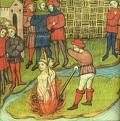
On Mar. 18, 1314 after years of fruitless attempts to torture out the whereabouts of their treasure, 39 more Knights Templar are burned in Paris, incl. grandmaster #23 (last) Jacques de Molay (Molai) (b. 1244) and his deputy Geoffroi de Charnay (Charney) (Charny) (b. 1251), preceptor of Normandy; they are slow-roasted over smokeless charcoal, taking hours to die?; in the flames de Molay (who had been tortured into a confession of heresy and given life in priz earlier that day, only to immediately retract it and ordered burned) protests the innocence of the Templar Order, and calls down Philip IV and Pope Clement V for their injustices, launching the Templar (De Molay) Curse, and sure enough they both croak later this year, popey going first in only 33 days?

In Sept. 1314 Philip IV's minister (since 1304) Enguerrand de Marigny (1260-1315) negotiates a peace with the Flemings, pissing-off the princes of the blood, who are eager to fight them; after Philip IV dies he is arrested by order of Louis X at the instigation of Philip IV's brother Charles of Valois for bribery, and beats the charge, only to be framed on sorcery and hanged next Apr. 30 in Montfaucon.

On Nov. 29, 1314 after the loot from the Jews and Templars, as well as all the overtaxation measures he has instituted still don't bail the treasury out of its war debts, causing him to call another estates-gen., which bickers and doesn't cough up any more moolah, king (since Oct. 5, 1285) Philip IV (b. 1268) dies, and his son Jeanne of Navarre becomes Capetian king #12 Louis X (the Quarrelsome) (the Quarreler) (the Stubborn) (1289-1316) (until June 5, 1316); his reign is dominated by his uncle Charles of Valois, while Philip IV's other sons Philip V (1294-1322) and Charles IV (1294-1328) wait in line; a plan to steal Gascony from the weak English king is put in motion, while a reaction against the monarchy forces concessions; John Tannere (Canne), who claims to be the son of Edward I is hanged, drawn, and quartered as a traitor - did it look like a boa constrictor?
In July 1315 French king Louis X pub. an ordinance that Nature makes every man free, hence all slaveholders must free their slaves - but if they don't he will do what?
In 1315 after the king's loan collectors piss them off with their heavy-handed tactics, the people of France successfully clamor for the return of the Jews, who had been expelled in 1306; too bad, they are expelled again in 1322.
In 1315 the town of Schirmeck ("protected place") in Alsace is first mentioned.
On May 31, 1316 after receiving his doctor of theology degree from the U. of Paris, Cesena, Italy-born Franciscan theologian Michael of Cesena (1270-1342) is elected minister gen. of the Naples chapter, and travels to Assisi, where he convokes a chapter to revise the order's constitutions, issuing the document Gravi qua premor on Aug. 21, advocating ecclesiastical poverty to be like Christ and his Apostles, pissing-off Pope John XXII, who pub. the bull Quorumdam exigit on Oct. 7, 1317, declaring heretical the belief that since Jesus and his disciples owned nothing, the Church should do likewise; in 1318 he orders 25 pesky poor-mouthing Franciscans tried by the Inquisition in Marseilles, and after all are found guilty of heresy, four are burnt alive by French king Philip V as incorrigible heretics, pissing-off Cesena and his supporters incl. Berengarius of Perpignan and William of Ockham, who are opposed by inquisitor John of Belna, who in a disputation in Narbonne in 1321 claims their views to be heretical; on Mar. 26, 1322 Pope John XXII pub. the bull Quia nonnunquam, distinguishing between dominion and simple use in a compromise attempt; in June 1322 a gen. chapter of the Franciscan Order is convoked in Perugia, deciding that Christ and His Apostles possessed no earthly goods; on Dec. 8, 1322 Pope John XXII pub. the bull Ad conditorem canonum, forcing the Franciscans to accept ownership of their property, reversing Pope Gregory IX, who ruled that all Franciscan property belonged to the Holy See; in 1323 Pope John XXII pronounces false the proposition that Christ and his apostles had owned no property (which was approved by Pope Nicholas III in 1279), making the Spirituals (Zealots) of the Order of St. Francis into heretics, subject to be burned by the Inquisition; in 1328 after stalling for a year, Cesena appears before the pope in Avignon, and is excommunicated, while his supporters flee to Naples but are forced by a storm to land in Pisa, and HRE Louis IV deposes the pope; on June 11, 1329 after the pope gains control of the Franciscan Order, the gen. council of the Paris chapter condemns Cesena's views, and he is deposed from his leadership position and replaced by Gerard Odon (Geraldus or Gerardus Odonis) (Guiral Ot) (1285-1349); in 1330 the pope issues the encyclical Quia vir reprobus, warning the faithful against Cesena, who accuses the pope of heresy in his letter Ad perpetuam rei memoriam innotescat quod ego, Fr. Michael on Nov. 25, 1330; on Apr. 25, 1331 the Franciscan chapter in Perpignan expels Cesena from the order and sentences him to life imprisonment, and he fights for his cause until his Nov. 29, 1342 death in Munich; he is officially rehabilitated in 1359; meaanwhile on Nov. 28, 1336 new Pope (1334-42) Benedict XII confirms Odonis' Constitutiones Benedictinae, which are abrogated by the gen. chapter in Assisi on June 1, 1343, restoring the 1260 Constitutions of Narbonne.

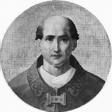

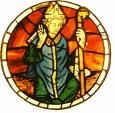
On June 5, 1316 king (since Nov. 29, 1314) Louis X the Quarreler of France (b. 1289) dies suddenly of pleurisy caused by overindulgence in cold wine after becoming overheated playing ball, and on Nov. 15 his posth. infant son (by his 2nd wife Clemence of Hungary) Jean (John) I (b. 1316) becomes unlucky Capetian king #13, with his uncle Philip the Tall as regent, but dies after five days on Nov. 20 (oops, who left that pillow on his face?), leaving only Louis X's infant daughter (by his 1st wife Margaret of Burgundy) Jeanne, and since the Salicylic Lobby conveniently says that monarchs with PMS and no Midol yet on the market are out, a great nat. council gives the crown to Louis X's younger brother Philip V the Tall (1294-1322), who becomes Capetian king #14 (until Jan. 3, 1322), solidifying the male supremacist Salic Law excluding women from succession to the French throne; a rabid anti-Semite, Philip V makes admin. reforms and attempts to unify weights and measures to keep up with Edward I of England, but bumps up against opposition in the estates-gen; meanwhile after two years of failure to elect a new pope, he convenes a conclave of cardinals in Lyons, which on Aug. 7 elects Jacques Duese as Pope (#195) John XXII (1249-1334); when the new pope refuses to crown Louis IV the Bavarian as HRE, he starts a propaganda war, led by Marisilius of Padua (1270-1342) and William of Ockham (Occam) (1280-1347), challenging the power of the papacy and attempting to revive the prestige of the empire; Marsilius of Padua founds the Conciliar Movement (Conciliarism), which claims that a gen. council is superior to a pope, can be called by a king, and is competent to judge a pope or call a new conclave, which is given a more forceful form in 1379 by Henry of Langenstein (1325-97), gaining a large following.
Swiffer gives cleaning a whole new meaning? In 1318 Inquisitor Jacques Fournier (1285-1342), bishop of Pamiers (future Pope Benedict XII) has fun with the remaining Cathars (Albigensians) in the village of Montaillou in the Pyrenees of S France, arresting the entire village of 250 after conducting lengthy interviews with dozens of them.
In 1318 after Pope John XXII declares heretical the belief that since Jesus and his disciples owned nothing, the Church should do likewise, he orders 25 pesky poor-mouthing Franciscans tried by the Inquisition at Marseilles, and after all are found guilty of heresy, four are burnt alive by French king Philip V as incorrigible heretics.

In 1318 Jeanne (Joan) III of Burgundy (1308-47), eldest daughter of Philip V the Tall of France and Joan II of Burgundy marries Duke Eudes (Odo) IV of Burgundy in exchange for relinquishing the right of her cousin (Eudes' niece) Joan II of Navarre (daughter of Louis XI and Margaret of Burgundy) to inherit the French throne.
On May 5, 1320 the Peace (Treaty) of Paris between Count Robert III of Flanders and Philip V of France is signed by Count Robert of Bethune, ending a war begun during the brief reign of John I; Philip V of France acquires some Flemish territory.
In May 1320 a French shepherd boy in Normandy has a revelation or vision, beginning the Shepherds' Crusade; 30K Christian shepherds set out to attack the Muslim Moors in Spain, change their minds when they see they can fight back, do what comes natural, and begin ravaging defenseless Jewish communities in S France and N Spain incl. Saintes, Verdun-sur-Garonne, Cahors, Albi, Toulouse, and Montclus before they are finally dissolved?
In 1320 the ancient Gaulic capital of Lyon(s), France receives a municipal charter along with a coat of arms.
In 1321 King Philip V the Tall of France admits that the Jews are innocent of encouraging lepers to poison Christian wells, but only after 5K Jews have been murdered; Jews are required to wear yellow badges and forced to pay heavy fines for killing the Son of God and rejecting him as their Savior, thus insuring eternal Hellfire anyway?

On Jan. 2, 1322 king (since Nov. 20, 1316) Philip V the Tall (b. 1294) dies, leaving a large number of royal ordinances but (poetic justice considering how he got the throne?) no male heir (only daughters Jeanne, founder of the House of Burgundy, and Margaret, founder of the House of Flanders), and his younger brother Charles IV the Fair (1293-1328) becomes the 15th and last king of the French Capetian Dynasty (begun 987), cutting off Edward III of England (grandson of Philip IV through his daughter Isabelle) (no fair?), which finalizes the no-cu, er, no-female-inheritance principle of the Salic Law as recursive; he kicks his reign off right by expelling the pesky money-grubbing Jews from France, who had been expelled in 1306 by Philip IV then allowed to return in 1315; meanwhile the French crown controls the papacy, and the rulers of the Capetian house of Anjou are still seated on the thrones of Naples, Provence, and Hungary; only Brittany, Flanders, Guienne, and Burgundy remain outside French royal control - what's left is a world where old friends suddenly become enemies?
In 1323 the Consistori del Gay Saber (Academy of the Gay Science) lit. academy is founded in Toulouse, France, sponsoring poetry competitions among troubadours.
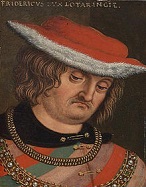

In 1324 after Charles IV builds a fortress illegally on Edward II's territory in Aquitaine, and the Despensers imprison Charles IV's sister Isabella of France, an French expedition is sent to Aquitaine. In 1324 after the bourgeoisie of Metz, France incur a mountain of debts, the War of Metz (Four Lords' War) (ends 1326) sees Duke (since 1312) Frederick IV "the Fighter" of Lorraine (1282-1329) (nephew of Count Charles III of Valois), Bohemian king (since 1310) John (Jean) (the Blind) of Luxembourg (1296-1346), and archbishop-elector of Burgundy (since 1307) Baldwin of Luxembourg (1285-1354) organize a coalition to capture the city and make them pay; they're all of Merovingian blood? In 1324 metal cannons are invented by Rinaldo di Villamagna, and used in the Siege of Metz, becoming their first use in Western Europe?
In Mar. 1325 after Pope John XII forces them to come to term with its citizens, peace is restored in Metz; next year the Peace of Herrings (named after their major food source after the lords block their trade routes) is signed in Ponit-a-Mousson, and the burgesses promise to not set up markets on their lords' fiefs without consent.
In 1325 Louis I of Nevers (1272-1322), count of Flanders, Nevers, and Rethel since 1322 is imprisoned by the communes under English influence (until 1326), pissing-off the French king and causing him to plan a campaign against the buggers, er, burghers.

Isabella the She-Wolf of France finally gets the hot beef she wants? In 1325 after Charles IV of France seizes Edward II's French possessions, definitely not-getting-much English Queen Isabella of France (1295-1358) is sent to negotiate peace with her brother, later tricking Edward into sending 13-y.-o. Edward III after her, while she hooks up with Roger Mortimer, 1st Earl of March (1287-1330), an ambitious exiled Marcher Lord, a mortal enemy of the Despensers (because his grandfather had murdered their grandfather?), who with her probable help had escaped from the Tower of London in 1323 and who, unlike her weak, incompetent, suspected dickwhipped faggot husband Edward II gives her the hot mortadella she likes, carrying on an adulterous relationship which gets them kicked out of the royal court even though Charles IV refuses Edward II's demand to return her to England, after which they find refuge with Count William I of Hainaut, whose wife is Isabella's cousin; they go on to conspire with the large group of English exiles in Paris and disaffected English nobles to make a comeback.
On Apr. 26, 1326 the 1326 Treaty of Corbeil renews the Auld Alliance between Scotland and France; in July the Scottish parliament passes an Act of Succession recognizing Prince David as heir apparent, followed by Robert Stewart; meanwhile Robert I becomes the first Scottish king so broke that he has to ask his subjects for annual taxation for his living costs.
In 1326 the first paper mill in Christian Europe is built in Ambert in Auvergne, France, followed by Troyes in 1338, Nuremberg in 1390, and Leira, Portugal in 1411.
On Apr. 6, 1327 (Good Friday) after giving up his vocation as a priest, Petrarch glimpses a babe named Laura in the Church of Sainte-Claire in Avignon, and though she doesn't return his love, he obsesses on her for life? - after flogging his bishop over her for decades, she always looks in his mind's eye like that sweet succulent young thing?
In 1327 the French, helped by the English vassals conquer a good chunk of E Gascony, and Edward III's regents sign a treaty permitting them to keep most of it, car-door ears and all, but the F rench only turn up the pressure to gobble it all up and squeeze the English king out of France, leading to the Hundred Years' War in 1337 - swallow rather than spit?
In 1327 the province of Bourbonnais in C France becomes the duchy of the house of Bourbon, with capital at Bourbon (until 1523).



On Feb. 1, 1328 king (since Jan. 3, 1322) Charles IV the Fair of France (b. 1294) dies without male heir, leaving only a useless woman, Blanche (his daughter through his wife Blanche of Burgundy, who marries Philip of Orleans and founds the House of Orleans), ending the direct line of the Capetian kings; after an assembly of barons declares that "no woman or her son could succeed to the monarchy", regent Count Philip of Valois, son of Count Charles of Valois (brother of Philip IV) and his wife Margaret of Anjou is crowned Philip VI (1293-1350) at Rheims, becoming the first French king of the Valois Dynasty (ends 1589), using the Salic Law to set aside rival claimants, particularly pesky Edward III; Louis X's only daughter Joan II of Navarre (1312-49), also prevented by the Sexalic er, Salic Law from becoming the monarch becomes queen of Navarre (where the Salic Law doesn't apply), renouncing her claims to the French throne as well as her lands in Brie and Champagne in return for extensive lands in Normandy (Angouleme, Mortain and Longueville) (later exchanging Angouleme for three estates in Vexin); free at last to help Louis of Nevers, Count of Flanders and avenge the 1302 Day of the Spurs, Philip VI sends his French troops to slaughter the whimpy Flemish burgers, er, burghers at the Battle of White Castle, then the less-white Aug. 23 Battle of Cassel 20 mi. S of Dunkirk, at which Charles IV is saved by Philip III of Navarre (the Noble) (the Wise) (1306-43), hubby of Joan II of Navarre; Charles V establishes a French admin. in Flanders, which pisses-off Edward III and leads to the Hundred Years' War (1337-1453).
On Aug. 23, 1328 the Battle of Cassel 18 mi. S of Dunkirk, France is a decisive V for 14.5K French soldiers led by Philip VI over 6.5K-8K Flemish independence rebels led by Nicolaas Zannekin, who lose 3,185 KIA.
In 1330 Countess Jeanne III of Burgundy inherits the county of Artois and the "free county" of Burgundy (Franche-Comte) (capital Besancon), which has been subject to the HRE since 1034, and ends up being separated from the duchy of Burgundy in 1477 and going to Austria in 1481 and Spain in 1556 before returning to France in 1678.
In 1330 the Menetriers (Paris Musicians' Guild) is founded (until 1773).

In 1334 the Cistercian-style Papal Palace (Palais des Papes) in Avignon, France is begun by Pope (1334-42) Benedict XII (finished in 1362); his successor (1342-52) Pope Clement VI adds a Gothic-style New Palace with massive towers and 165-ft. stone walls to show the grate powah of the papacy.

We can't go on together with suspicious minds? On May 24, 1337 after Philip VI conquers the larger part of the English possessions in France S of the Loire, and comes to the aid of Scotland against England, causing Edward III late in the year to cease leading Scottish campaigns in person and declare war on France over these issues as well as the problem of French control of Flanders (which has become interdependent with England because of the wool trade), using his dormant claim to the French throne through his mother Isabelle (Philip IV's daughter) as a pretext, even though it had been excluded by the French courts under the Salic Law, the 116-year Hundred Years' War begins (ends Oct. 19, 1453), which is characterized by the frequent use of the chevauchee using small groups of horsemen to pillage enemy territory to draw the enemy into a fight; England allies with the Count of Hainault and Holland (Edward's father-in-law), as well as HRE Louis IV the Bavarian (because Philip VI is the protector of new Avignon pope Benedict XII, and prevented any agreement between them over his investiture); the rebelling weavers of Ghent, led by wealthy Flemish brewer Jacob van Artevelde (the Wise Man) (the Brewer of Ghent) (1290-1345) virtually take over Flanders, causing Artevelde to be made capt.-gen. of the city, then welds the Flemish cities into a federation committed to armed neutrality.
In 1339 self-proclaimed French king Edward III (1312-77) of England invades and ravages N and E France, sacking Dieppe, but is unable to repay a $7M loan to finance the war, and is brought under a petition of bankruptcy, becoming the first Euro nat. ruler to declare bankruptcy - do the math?
On June 24, 1340 after Edward III makes a political alliance with the Flemings, who recognize him as the king of France and overlord of Flanders, causing the French to declare Edward's French fiefs forfeited and siege Guienne and burn Portsmouth (home of the Pomponians), the naval Battle of Sluys (Sluis) (d'Ecluse) on the Scheldt estuary on the coast of Flanders sees Edward III with 150 ships defeat the somewhat larger fleet of Philip VI of France (who made the boo-boo of dismissing two squadrons of mercenary ships from the Levant), and entirely capture or destroy it, gaining complete control of the Channel for England (until 1372), as well as free access to N France; after Edward's army plods around in France awhile without significant success, the countries make a truce; HRE Louis IV and Edward III sign the Alliance of Coblenz,making Edward vicar of the empire and recognizing his title of king of France, turning the Hundred Years' War into a struggle for the English to keep "their" French empire.
In 1341 Mars, Jupiter, and Saturn are in conjunction this year, causing French astronomer John (Johannes) (Jehan) de Murs (Muris) (1290-1355) to later tell Pope Clement VI that this is the cause of the Black Plague.
In 1343 the 52 commununes of Briancon in France receive a charter of liberties.
In Jan. 1345 the French parliament decides in favor of Charles de Blois in the matter of the succession of Limoges.

On Mar. 18, 1346 the French prepare to defend their English Channel coasts. On Apr. 1 the French led by Duke John of Normandy begin the Siege of Aiguillon in Gascony, defended by Earl Henry of Lancaster, tying up the main French army; on Aug. 20 after a dysentery epidemic in their camp the French withdraw. In May an English invasion fleet begins assembling in Portsmouth. On June 9 the Battle of St. Pol de Leon (Léon) sees the 180-man English army under Sir Thomas Dagworth (1276-1350) defeat the 1K-man army of Charles of Blois in Brittany, becoming a turning point for the Montfortists and their English allies in Brittany. On June 20 the Battle of La Roche-Derrien in Brittany is a small English V. On June 24 the leaders of Ghent, Bruges, and Ypres agree to support Edward III in an invasion. On July 3 the English fleet sails from Portsmouth to Normany, but is forced back by strong winds, after which Edward III orders the closing ports to prevent intel leaks to the French. On July 11 after appointing Queen Philippa as regent of England in his absence, Edward III and his 16-y.-o. son-heir Prince Edward of Woodstock (1330-76) (later the Black Prince) set sail for Normandy with a 15K-man army, arriving on July 12 at Saint-Vaast-la-Hogue 20 mi. from Cherbourg, taking the French by surprise, raiding and burning towns and villages in the Contentin Peninsula incl. Carentan, Saint-Lo, and Torteval until July 18, while the English fleet shadows them, capturing or burning 100+ French ships, and converting 61 into military vessels while looting the countryside for up to 5 mi. inland, causing some ships to fill their holds and return home; the English force incl. at least one Norman baron unhappy with Philip VI's rule. On July 26 the Battle (Siege) of Caen is a V for the 12K-15K-man English army of Edward III over a garrison of 1K-1.5K soldiers and a large number of armed townsmen, who fall in the first assault, losing 5K KIA plus a few nobles taken POW, after which the English sack the town for five days before burning it. On Aug. 1 the English army marches toward the Seine River/ on Aug. 2 another small English force invades France from Flanders. On Aug. 24 after the French garrison all the bridges and fords over the Somme River and chase the English army, who find the land stripped of food supplies, trapping them, the Battle of Blanchetaque 10 mi. from the English Channel and just S of Crecy sees a French force under Godemar I du Fay (-1350) attempt to prevent the English from fording the Somme River, ending up fleeing, allowing the English to head N. On Aug. 26 after following the Seine River to within 20 mi. Paris, then heading for Flanders, ending up intercepted and trapped at the Somme, discovering a ford just in time and digging-in on some hills near Crecy (where the horsemen dismount), the Battle of Crecy (Crécy) S of Calais and NW of Amiens is a V for Edward III's 10K-man force (which is 0-1 after Sluys) over Philip VI and his 20K undisciplined cavalry and mercenary crossbowmen; blind King John of Bohemia (b. 1296) is KIA; Prince Edward, in command of the right wing of the English army wins his spurs; gunpowder artillery is used for the first time in Europe?; the first time that the English longbow (made possible by the amazing elasticity of yew wood) triumphs over the (Genoese) crossbow, marking the first joint participation of yeomen and aristocrats in war, made possible by their experiences in Wales and Scotland; as a consequence of this battle, knights begin to put heavy plates over their chain mail, and by the end of the cent. they wear complete armor-plated suits - are you crecy?
The Black Death (the original Darth Vader) rockets through Europe's Internet with breathtaking speed? In Oct. 1347 a Genoese trading fleet arrives in Messina, Sicily carrying the Black Death (Bubonic Plague), caused by Yersinia pestis bacteria carried by fleas from rats; not rats but gerbils?; it also arrives in Egypt, Syria, and Cyprus; by 1351 it kills 20M-30M in Europe (a third of Europe's pop., and up to 60% in some areas), and 75M worldwide by 1361; world. pop. decreases from 450M to 350M-375M by 1400; Europe takes 150 years to return to 1347 pop. levels; it ravages China, halving its pop. from 123M in 1200 to 65M in 1400; lucky America is not affected, but not toughened up by it either?; rats didn't really spread it, because it spreads so fast from person to person?; French Franciscan Order minister-gen. (since 1329) Gerard Odon (Geraldus or Gerardus Odonis) (Guiral Ot) (1285-1349) is asked by the pop. of Messina to retrieve the relics of St. Agatha from Catania, and when they refuse he dips them in holy water and takes instead, dying of the plague on his return trip.
In Jan. 1347 the Black Death begins in Marseille and Languedoc, spreading to Avignon in Mar., and Siena, Toulouse, Narbonne, Montpellier, and Carcassone in May; after the cemeteries are filled, bodies are piled high on the Campus Floris near the Church of St. Mary of the Miracles; in June it spreads to Spain, and Bordeaux, Lyon, Burgundy, Normandy, Paris, and SW England in Aug., along with Howth and Drogheda in Ireland; Agnolo di Tura the Fat of Siena, Italy writes the soundbyte: "The mortality in Siena began in May. It was a cruel and horrible thing. The victims died almost immediately. They died by the hundreds, both day and night. I buried my five children with my own hands, and so did many others likewise. Nobody weeps no matter what his loss because almost everyone expected death. So many died that all believed it was the end of the world"; it then disappears for the winter, except Ireland, which it decimates; the Great Plague results in horrible Jewish pogroms throughout Europe, incl. Chillon, Basle, Stuggart, Ulm, Speyer, Dresden, Strasbourg, and Mainz, destroying 60 major and 150 minor Jewish communities, causing survivors to head for Poland, which welcomes them as Kasimir III reworks the Polish law codes; in Strasbourg 2K Jews are hanged; in Freiburg ? are burned alive in wooden bldgs.; Basle burns 600 Jews, expels the rest, and destroys their synagogue and cemetery; Alfonso XI of Spain proposes that the Jews give up banking and take up agriculture; meanwhile, Millennium Fever is on full blast, and when terrible earthquakes rock Italy, this combined with the plague convince people that the end of the world is nigh.
In spring 1349 the French unsuccessfully attempt to recapture Calais.
In summer 1349 the Great Plague reappears in Paris, where it peaks, killing up to 800 a day, and spreads to Picardy, Flanders, and the Low Countries; also in the summer it reappears in London, and spreads to Ireland, killing 35% of the pop. within a year; by the middle of the year half of the pop. of Venice is killed; by the end of the year half of England's pop. is killed, and a truce with France is called; the plague spreads to Norway when an English ship full of corpses floats into Bergen, and reaches Elbing (Elblag), Poland on Aug. 24; the Church and its credibility being challenged head-on, the main solution offered is by the Flagellants, who appear in force all over Europe (especially Germany), torturing themselves publicly, and proclaiming that the Second Coming is 33.5 years away (I been a bad, bad boy, so tan my sinful hide?), while causing trouble for Jews, the rich, the Church, and finally themselves (besides all the wounds), causing Pope Clement VI to pub. a bull condemning them on Oct. 20; "Many persons, and even young children were soon bidding farewell to the world, some with prayers, others with praises on their lips."
In 1349 Count Humbert II, the last dauphin (Fr. "dolphin") of Vienne in SE France sells the (bottlenose?) region of Dauphine (Dauphiné) (English Dauphiny) (originally the County of Albon) in the old kingdom of Arles or Burgundy to Charles Valois (who becomes Charles V in 1364), and thereafter the eldest son (heir apparent) of the French king is called the dauphin (until 1830), with him becoming the first, which makes sense since the title of king of Arles was a favorite of Frederick I Barbarossa and other German HREs, and the title of prince of Wales has been used by the English since Edward II.

On Aug. 22, 1350 Philip VI of France (b. 1293) dies, and on Sept. 26 his luxury-loving boob son (by his wife Jeanne of Burgundy), the duke of Normandy John (Jean) II the Good (1319-64) ("a good knight and a mediocre king") is crowned Valois king #2 of France in Notre Dame de Reims (until Apr. 8, 1364), and stages a royal entry into Paris on Nov. 11, going on to become a spendthrift and repeatedly debase the currency, appointing brutal thieves to administer his kingdom; on Nov. 19 popular constable of France Raoul II of Brienne, Count of Edu and Guines (b. 1315) is executed in Paris on the king's orders after being released by the English to seek his ransom and rumor to have pledges his county of Guines in return for his release, ending the king's honeymoon with his nobles.
In 1351 the Black Death (begun 1347) reaches Russia, but suddenly begins to decline after 25M-75M are killed throughout Europe; the new reduced pop. mix leads to political and social upheavals, incl. the enclosure of land for sheep raising, accumulation of great fortunes (causing the baronage to lose status), an increase of uppityness of the yeomanry, and an increase in conspicuous consumption (bigger houses, etc.)?
On Jan. 5-6, 1352 the Order of the Star, founded the previous year by King John II of France holds its first and only meeting, and proves a flop - King John is no King Arthur?
In 1352 the French town of Guines surrenders to the English.
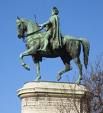
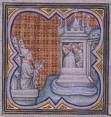
The Estates reach their peak of power in France under Etienne Marcel and Big Bob Le Cock? In Feb.-Mar. 1357 after backing by Etienne Marcel, the Estates-Gen. issue the Grand (Great) Ordinance of 1357, a sweeping reform of the French monarchy and govt., providing for a standing committee to supervise levy and expenditure of taxes, poor relief, and other reforms, without attempting to mess with the traditional powers of the monarchy; they force Dauphin Charles to sign it as regent of France; in May King John II repudiates it, and the Marcel-Le Coq Revolt, led by Etienne Marcel (-1358) and Bishop (of Laon)Robert Le Coq (-1373) of Laon begins against Dauphin Charles in Paris, with Marcel's Great Ordinance of 1357 setting limits on the French monarchy, causing him to flee and gather a powerful coalition; meanwhile Marcel stinks up the rebellion by allying with bad bad Charles the Bad of Navarre.
On Mar. 23, 1357 the 10-year Truce of Bordeaux ends the English invasion of France; too bad, the negotiations are transferred to England, and the treaty never ratified; one of the terms is that the siege of Rennes by the English be lifted, but the duke of Lancaster continues until they buy him off in July; the discharged English mercenaries turn into highwaymen in the Rhone Valley et al.

In 1357 the Bastille (originally Bastille Saint-Antoine Castle) is built to protect the strategic gateway of the Port Saint-Antoine on the E side of Paris from the pesky English; construction drags along until the 1370s; in 1417 it becomes a state prison; Louis XIV uses it to imprison nobles and Huguenots; by 1789 it houses 5,279 prisoners, some of whom write autobios. complaining of bad conditions, causing reforms to be implemented and the prison pop. to be considerably reduced by the time of the July 14, 1789 Bastille Day.


On Jan. 11, 1358 as he vies with Dauphin Charles for supremacy in France, Charles the Bad of Navarre enters Paris, and Etienne Marcel (b. 1302), provost of the Parisian merchants raises a crowd and storms the Palace of Les Halles, killing many nobles and turning them all against him; in May the dauphin orders the nobles to blockade Paris; on May 28 the Jacquerie, a peasant ("Jacques") revolt begins in St. Leu, France, fueled by war taxes and the pillages of the Brigand Cos. (demobilized soldiers), who during the summer cause a collapse of the govt. outside Paris; on June 10 several thousand Jacques storm Mello and Meaux in Beauvais, NE Paris (residence of the royal family) and are defeated, causing the tide to turn against them; in June Charles the Bad of Navarre kills Guillame Caen, leader of the Jacques; the remaining Jacques are hunted down and killed by June 24; in July Charles the Bad reenters Paris, making a bad bid for the crown, with Marcel's support, on July 22 bringing a band of hated English soldiers into Paris, causing an enraged mob to attack and drive them into the Louvre; on July 31 Marcel orders his guard to give the keys of the city to Bad Charles, but they balk, and Marcel is trampled to death on the streets by the mob; on Aug. 2 Paris opens its gates to Dauphin Charles, who pardons everybody after a little foolin' around with angry crowds; meanwhile, Bad Charles defies him and renews his alliance with Edward III.
On Mar. 24, 1359 John II signs the 2nd Treaty of London, surrending most of W France (the old Angevin lands), and agreeing to pay a ransom of 4M gold ecus; on May 25 the Estates General rejects the treaty and make preparations for a war with England; in Aug. Charles the Bad of Navarre reconciles with dauphin Charles and the king; Edward III arrives in Calais at the end of Oct. with a large army, but the dauphin issues a policy of avoiding pitched battles; Geoffrey Chaucer joins Edward III's army and goes with it to France; in Nov. Edward III takes Nogent-sur-Seine in Champagne, then unsuccessfully sieges Paris and king-crowning-city Reims in Dec., and Geoffrey Chaucer is captured; S France has been so devastated by the English that they have trouble finding food? - how about champagne?
In Jan. 1360 Edward III raises the siege of Reims and marches to Burgundy to pillage it, but is bought off with a ransom of 200K moutons to leave at the end of Mar.; Edward III pays Geoffrey Chaucer's £16 ransom in Mar.; in Apr. Edward III returns to the walls of Paris, challenging dauphin Charles to come out and fight; when he refuses, Edward begins to move towards Chartres, but on Apr. 13 (Easter) is caught by a terrific hailstorm on Black Mon., which kills many men and horses and causes him to sue for peace (3rd Black Easter Monday since 1209 and 1351); on May 8 the Peace (Treaty) of Bretigny (Calais), signed in the village of Bretigny 6 mi. SE of Chartres by Edward III, Philip I of Burgundy, and the dauphin brings the Hundred Years' War to a temporary halt; Philip II the Bold is released, and receives the duchy of Touraine; the SW third of France, incl. all of Aquitaine, Calais, and Ponthieu, plus the dinky Channel Islands; in return Edward III renounces his claims to the French throne as well as all claims to Anjou and Normandy, and his alliance with Flanders, while retaining Gascony and Guienne; France renounces its Auld Alliance with Scotland; the ransom is lowered to 3M ecus ($50M), and after the estate of Langue d'Oil grants it (for a term of 6 years) John II of France is released from captivity to raise the money for it in July; he marries off his daughter in order to get some quick money, which he turns over on Oct. 24, causing the treaty to be ratified in Calais; the Breton War of Succession (begun 1341) continues, and France is plagued by bands of unemployed marauding French and English mercenaries; the peace only lasts until 1369.
In 1360 the first francs are coined in France by order of John II, gold coins with the inscription "Johannes Dei Gracia Francorum Rex" (John by the Grace of God King of the Franks); they go out of circ. by the 2nd quarter of the 15th cent.

In 1360 French chivalry lover Jean Froissart (1337-1410) begins a long series of travels beginning with Avignon this year, England next year (where Queen Philippa appoints him secy.), Scotland in 1365, then Brussels, France and Italy, followed by becoming a priest in 1372 in Lestines in the diocese of Liege, where he spends 12 years compiling Froissart's Chronicles, then resumes his travels in 1386 to expand it, finishing with the 1400 death of Richard II of England.
About 1360 French Roman Catholic priest Jean Buridan (1295-1363) develops the Theory of impetus, which he defines as weight x velocity, becoming the precursor to the concepts of inertia, momentum, and acceleration.
On Apr. 6, 1362 after John II of France attempts to deal with the brigand cos. plaguing France they defeat his force at the Battle of Brigands, er, Battle of Brignas near Lyon.
In July 1362 the dauphin and the council disallow parts of the Treaty of Calais on the grounds that they give away too much; John II, feeling his honor is in dispute agrees to return to captivity in England, where he lives in luxury; meanwhile the S provinces of France chafe under their return to "foreign" English rule, showing signs of awakening nat. consciousness, after newlywed Edward the Black Prince is created prince of Aquitaine and Gascony by his father Edward III, and crosses the Channel to rule as a vassal of the French king, ruling ably but turning off the Gason nobles, who believe their feudal rights are being curtailed.
On Apr. 12, 1365 (Easter) the Treaty of Guerande (Guérande) ends the Breton War of Succession (begun 1341); Charles V recognizes John (Yann) (Jean) IV/V (the Conqueror) de Montfort (1339-99) as duke of Brittany, foiling the English, who wanted him to pay homage to Edward III.
On June 4, 1365 HRE Charles IV is crowned king of Burgundy, making him the personal ruler of all kingdoms in the HRE.
In June 1365 Charles V of France and Pope Urban V call for a Crusade in Hungary, to be led by French mercenary soldier (monk turned renegade?) Sir Arnaut de Cervole l'Archipretre (the Archpriest) (1300-66), leader of a brigand co. in France, the idea being to rid France of all of these "late-comers" (tard-venus) left over after the treaty was signed; as they try to leave France, however, the citizens of Jew-friendly Strasbourg refuse to let them cross the Rhine bridge, and they end up returning to France, after which Cervole is killed next year by his own lts. after pillaging Champagne and Lorraine.
In 1366 a promising Millennium Fever year (1-3-6-6) causes French ascetic Jean de Roquetaillade (-1362) of Avignon to predict the coming of the Antichrist this year.
In 1366 the 1K marks of annual tribute promised by King John I to the pope is 30 years in arrears, and when Edward III consults Parliament, the latter replies that they had never consented to it, so the payment is permanently ceased.
In 1368 After they get ridiculously impractical, Charles V bans the manufacturing of pointy shoes (Cracows) in Paris.
In Apr. 1369 Charles V launches an effort to revive the French fleet; in May, after the count of Armagnac appeals to him against the Black Prince and the latter refuses to appear at his court, Charles declares the Treaty of Bretigny void, then resumes the war with England, causing a revolt to spread through Aquitaine and Gascony; in June King Henry II of Castile and Leon concludes a naval treaty with France; John of Gaunt lands at Calais on July 26.
In 1369 Charles V the Wise of France tricks the Estates General into agreeing to make old grants of funds perpetual unless their terms are to be changed, freeing him from their control unless new taxes are needed, and transferring the financial control they grabbed in 1357 to his royal chambre de comptes in Paris.In 1369 Charles V the Wise of France negotiates the marriage of John II's son Duke Philip to Margaret III of Dampierre, Countess of Flanders (1350-1405), daughter and heiress of Louis II de Male (1330-84), the last count of Flanders (1346-84) in an effort to keep Flanders out of English hands.
In 1369 the Bastille (Bastille Saint-Antoine) prison at No. 232, Rue Saint-Antoine in Paris is built.
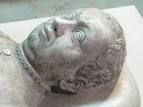
In Dec. 1370 after "the Eagle of Brittany" Bertrand du Guesclin (1320-80) is made constable of France, the French begin reconquering Poitou and Brittany, and score a number of bloody Vs against the English, earning Olivier III de Clisson (1336-1407) the title of "the Butcher" - the Black Olive?
In July 1373 John of Gaunt lands in Calais with a large army, then leads them around Paris to Bordeaux, arriving at Christmas; meanwhile French constable Bertrand du Guesclin sieges Brest, and seizes and holds most of the duchy of Brittany, earning the nickname "eagle of Brittany".
In June 1374 Edward III the Senile and Charles V the Wise agree to a 2-year French-English Truce, and Charles V makes hay while the sun shines, revamping the chain of command in the French army while continuing to revamp the navy and fortify Paris.
On Dec. 12, 1377 gouty aging HRE Charles IV visits Paris (until Jan.), wowing everybody and becoming the biggest event of the decade in France; on his progress to Paris he rides into towns on a gray horse instead of a white horse to downplay his imperial status.



On Sept. 16, 1380 French king (since 1364) Charles V the Wise (b. 1338) unwisely dies of mushroom poisoning, and his 12-y.-o. son (by wife Jeanne of Bourbon) Charles VI (the Well-Beloved) (the Mad) (1368-1422) is crowned Valois king #4 of France (until Oct. 21, 1422); his uncle Duke Philip II the Bold of Burgundy (1342-1404) becomes regent, and virtual ruler of France, although nominally sharing power with his other uncles, art-loving John the Magnificent of Valois, Duke of Berry (1340-1416) and Louis I of Naples (Taranto), Duke of Anjou (1320-62) ("the Princes of the Lilies"); meanwhile the men of Ghent siege, capture, and pillage Grammont in S France; the Hundred Years' War stalemates, with weak govts. on both sides languishing under internal disorders, and much of France in ruins; the English hold only Bordeaux, Bayonne, Brest, Calais, Cherbourg, and Valais; initially Charles is known as the Well-Beloved, until he suffers the first of his bouts of madness in 1392.
In Nov. 1382 Philip the Bold leads France on an expedition in support of his father-in-law the count of Flanders against the pro-Roman Catholic Flemish rebels under Philip van Artevelde (1340-82), and defeats them at the Battle of Roosebeke, massacring them "without pity, as though they had been but dogs"; van Artevelde is KIA; Duke Wenceslas of Brabant punishes the pop. of Louvain, Belgium so severely for an attempted insurrection that thousands of weavers emigrate to Holland and England, and it begins declining as an industrial town and turning into a univ. town.
In 1383 Scotland and France renew their Auld Alliance, with France promising support for a joint campaign against Richard II of England.

In 1384 Louis de Male, last count of Flanders dies, and through his daughter Margaret of Flanders, Duke (since 1363) Philip II the Bold of Burgundy (1342-1404) inherits Flanders, Franche-Comte (the county of Burgundy), Artois, Nevers and Rethel, pissing-off the Plantagenets with a bold new danger on the N and E; the town of Douai (Douay) on the Scarpe River in N France is among his new toys; meanwhile the duke of Anjou dies, leaving Philip II in the driver's seat that way, pissing off Charles VI, who declares himself of age and begins his personal rule by replacing him with his own brother Duke Louis of Orleans, and the rivalry between the bold houses of Burgundy and Orange is on.
In Aug. 1392 en route to Brittany with his army, French king (since 1380) Charles VI the Beloved (1368-1422) goes mad and kills four knights in the forest of Le Mans, and almost kills his brother Louis of Orleans, going on to become more and more mad, leading to his brothers stripping him of political power, which results in a power struggle between Louis of Orleans and John the Fearless, duke of Burgundy that makes it ripe for takeover by the English.
On Nov. 23, 1407 after getting pissed-off at English Queen Isabelle suddenly deciding that blood is thicker than wine and switching to his enemy's side, and despite vowing to their joint uncle Duke John of Berry to reconcile, Duke John the Fearless of Burgundy fearlessly has Duke Louis of Orleans (b. 1372) assassinated on the streets of Paris, calling it a justifiable act of "tyrannicide", and after escaping Paris and fighting off the Orleans party becomes the hero of Paris, gaining control of the French govt., which precipitates the (well-wined?) Burgundian-Armagnac Civil War (ends Sept. 21, 1435) between the pro-English Burgundians (supported by the pop., the U. of Paris, and the Wittelsbachs, and strong in the N and NE) and the anti-English Armagnacs, headed by Bernard VII, Count of Armagnac (1360-1418), future father-in-law of Louis' teeny son and future successor Charles of Valois, Duke of Orleans (1394-1465) (future father of king Louis XII) (supported by the great French nobles, and strong in the S and SE); torn by factional rivalry, the French make a truce with Henry IV, depriving the Welsh of aid.

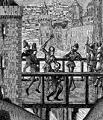
On Jan. 19, 1419 after Duke John the Fearless of Burgundy does nothing to prevent it, Henry V of England finishes the capture of Rouen, completing his conquest of all of Normandy except Mount St. Michel by July, opening the way to Paris (which is occupied by Duke John's troops); Norman French who fought against Henry V are severely punished, incl. Alain Blanchard, who hung English POWs from the walls and is summarily executed, and Robert de Livet, canon of Rouen, who excommunicated Henry V and is imprisoned in England for five years; the English occupy Dieppe 33 mi. N of Rouen (until 1435); Henry accuses his stepmother of witchcraft, claiming she caused his father's death, then seizes her money - of course? On July 11 Dauphin Charles parleys with Duke John the Fearless of Burgundy (b. 1371) on the Bridge of Pouilly (Pouilly-le-Fort) near Melun, swearing peace and agreeing to a 2nd parley, which takes place on Sept. 10 on the bridge in Montereau, and ends up as a mortal ambush of the duke. On Sept. 10 Duke John, who had been wavering in his support of Henry V after seeing him take Rouen and began negotiating with the Armagnacs is assassinated by Dauphin Charles' men during his parley with him at the Bridge of Montereau outside the dauphin's castle, and his son Philip III the Good (1396-1467) succeeds him as duke of Burgundy (until 1467), immediately throwing himself into Henry V's arms at Arras in order to take revenge, and developing a lifelong phobia for bridges; the French court does ditto, entering in a 6-mo. negotiation.
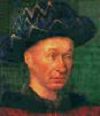
On Oct. 21, 1422 king (since Sept. 16, 1380) Charles VI the Mad (b. 1368) of France dies in Paris, and on Oct. 21 his girlie man son (by wife Isabelle of Bavaria) dauphin Charles claims the throne as French Valois king #5 Charles VII (1403-61) (Le Roi de Bourges) (until July 22, 1461), ruling S France with Armagnac help while waiting for a sign from God as the duke of Bedford's forces, supported by the Burgundians steadily crush him; meanwhile Henry VI is recognized as king of France in English-held N France incl. Paris.

In 1424 13-y.-o. illiterate pubescent seamstress Joan of Arc (1412-31), daughter of a prosperous peasant family in Domremy (Domrémy) in E France begins to hear voices from God telling her to kick English butt for her dear dauphin ding ding Charles?

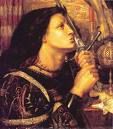
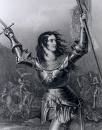

There are Nuts, and There are Planter's Roasted Nuts, or, Scent of a Woman Pt. II, or Do Lobsters Have Feelings, or, When They Come to Call On You and Drag Your Poor Body Down? On May 30, 1431 after Henry VI's uncle Duke John of Bedford (uncle of Jacquetta, Duchess of Bedford, mother of Elizabeth Woodville, wife of Edward IV) has French holy warrior babe (St.) Joan of Arc( Jeanne or Jehanne d'Arc) (b. 1412), "the Maid of Orleans" tried by a stacked French ecclesiastical commission and condemned as a heretic for dressing in men's clothes, she is burned at the stake in Rouen's old market square (Place du Vieux Marche), singing out the name of her Lord Jesus; chief judge Bishop Pierre Cauchon (1371-1442) denies her a lawyer and railroads her through the rigged jury of 60 clergy and theologians on the English payroll, then falsifies the trial minutes to cover it up; too bad for Bedford, her martyrdom only fans the flames of French nationalism, and forever afterwards the idea of England trying to rule any part of France gives off bad vibes.

On Sept. 1, 1501 Lucrezia Borgia marries her 3rd hubby (his 2nd wife) Alfonso I d'Este (1476-1534), son and heir to Duke Ercole I d'Este of Ferrara (d. 1505), a great art patron who finds her repugnant; when the duke dies in 1505, she and her husband take over Ferrara, establishing a court which becomes known for its artists, writers and scholars, while his army becomes known for its top-of-the-line artillery, which he is so proud of he poses for portraits with his arm over a cannon's mouth; meanwhile the accusations of intrigues, murders, and deviltry fly, starting with having his brother Ferrante and half-brother Giulio convicted in Sept. 1506 of treason and put on the gallows, after which their sentence is commuted to life in priz in the Torre dei Leono, after which Ferrante dies after 34 years, and Giulio is pardoned in 1559 after 53 years, being laughed at in the streets for his outdated clothes. Louis XII of France, in alliance with Ferdinand II the Catholic of Aragon conquers Naples; after the French enter Rome, Pope Alexander VI declares Louis XII king of Naples; the Peace of Trent in N Italy between France and HRE Maximilian I recognizes France's conquests in Upper Italy.



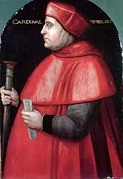




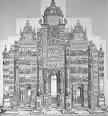



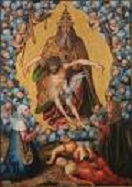
1515 On Jan. 1 king (since Apr. 7, 1498) Louis XII (b. 1462) dies, and Francis (Francois) I (1494-1547), son of his first cousin Charles d'Angouleme (1459-96) becomes French Valois king #9 (until Mar. 31, 1547), the first French Renaissance monarch, and "the father of France's devotion to culture", reigning at the same time as Henry VIII of England, and having to cope with the 1517 Protestant Revolution of Martin Luther too, but not copping out his religion over pretty petticoats like horny I'm Henry the Eighth I Am, staying loyal to the security cams of the Roman Catholic cause; too bad, he falls out with HRE Charles V, getting in ? wars with him for 38 years (1521-59); his favorite residence is the Palace of Fontainebleau 35 mi. SE of Paris on 200 acres in the 42K-acre Fontainebleau Forest, where he assembles the Fontainebleau School in the 1530s to decorate it; his well-educated brain babe sister Marguerite d'Angouleme (1492-1549) sets up a salon that becomes known as the "New Parnassus", fostering Francois Rabelais (1494-1553), Clement Marot (1496-1544), Pierre de Ronsard (1524-85) et al; Francis I signs an alliance with 15-y.-o. Archduke Charles of Hapsburg (Austria) (1500-58) (future HRE Charles V), who becomes gov. of the 17 provinces of the Netherlands; on Mar. 24 Francis I makes his friend and cousin Count Charles III de Montpensier and de Bourbon, Duke of Chatellerault (1490-1527) the (youngest ever?) constable of France (until 1523); Francis I hires German Landsknecht mercenaries,and makes a brilliant crossing of the supposedly impassable Alps, followed by a brilliant military V on Sept. 13-14 over the Swiss and Venetians at the Battle of Marignano, where the superiority of artillery and cavalry over the supposedly superior Swiss infantry tactics is proven, then a few days later defeats Swiss mercenaries and seizes the Italian duchy of Milan, becoming its gov. (until 1519); after conquering Lombardy, the French make peace with the Swiss on Nov. 12 and with Pope Leo X on Dec. 14; the Swiss retain most of the Alpine passes plus a French subsidy in return for the right of the French to enlist mercenaries; Francis I becomes the first French king to appoint port-chaise-d'affaires (royal porta-potty attendants).
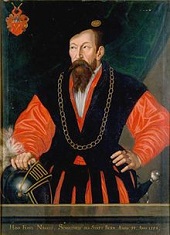
On Mar. 31, 1536 after Protestant Geneva revolts against the authority of the duchy of Savoy and repudiates the authority of its Roman Catholic bishop, Swiss forces from Bern under Hans Franz Nageli (Nägeli) (1497-1579) take Lausanne, followed by Vaud (N of Lake Geneva) and other territories from Savoy, who all join the Swiss Confederation; HRE Charles V triumphantly enters Rome and delivers a speech before Vatican officials publicly challenging Francis I of France to a duel; the Bernese who conquer Vaud release writer Francois Bonivard (Bonnivard) (1493-1570), "the Prisoner of Chillon", who goes Protestant after four years of captivity.

Here comes the Sun King - pass the Pampers? On May 14, 1643 sickly king (since May 14, 1610) Louis XIII (b. 1601) dies of TB, and his 4-y.-o. son Louis XIV (the Great) (the Sun King) (1638-1715) becomes Bourbon king #3 of France (until Sept. 1, 1715), with his mother Anne of Austria as regent, who falls to her knees and cries "My king and my son!"; she confirms Cardinal Mazarin as first minister; he is partial to mistresses, beginning with his Roman-born niece Marie Mancini (1639-1715), and to white bechamel sauce, made by his chief steward Louis de Bechamel, Marquis de Nointel (1630-1703), and thinks of England as "a little garden full of sour weeds"; after Louis XIV grows up into a short man, he begins wearing a towering wig to appear tall, starting a fashion; he continues mixing the Bourbon line with other brands, er, branches, with his brother Philip founding the House of Orleans, and his grandson Duke Philip of Anjou becoming Philip V of Spain and founding the Spanish House of Bourbon.

On May 19, 1643 five days after Louis XIII's death, 25K Spanish invaders from the Netherlands led by Gen. Francisco de Melo (1597-1651) living under an illusion of invicibility are defeated by a French citizen army of 23K led by 22-y.-o. Louis II de Bourbon, Duc d'Enghien (1621-86) (prince of Conde in 1646), who uses cowboy tactics with his cavalry, combined with superior artillery against the unbeaten Spanish infantry at the Battle of Rocroi, the last big battle of the Thirty Years' War, ending Spanish military ascendency in Europe and clearing the way for French ascendency under Louis XIV; Louis II becomes a hero, and is made a prince in 1646, and later called the Great Conde; unpopular Spanish PM (since 1621) Count-Duke Olivares becomes the fall guy, and retires to Toro, and is succeeded by his nephew Luis Menendez de Haro y Sotomayor, 6th Marquis of Carpio, 3rd Duke of Olivares (1598-1661); too bad, Spanish "Blue Nun" Maria Fernandez Coronel, Abbess of Agreda (1602-65)) gains influence over him, causing him to abolish the function of valido, which put a PM in charge of all documents given to the king to sign, reducing his power greatly.

On June 26-July 28, 1643 the Bavarians under gen. Franz von Mercy (1590-1645) siege and capture Freiburg-im-Bresgau, then dig in in the surrounding mountains; on Aug. 3-5 after Louis II de Bourbon, duc d'Enghien (prince of Conde in 1646) arrives with reinforcements to aid new field marshal (since 1642) Henri de la Tour d'Auvergne, Vicomte de Turenne (1611-75), the French defeat the Bavarians at the desperate Battle of Freiburg (Freiburg-im-Breisgau) (not to be confused with the 1762 Battle of Freiberg), at which the cowboy duc fails in a direct attack, and Turenne brings it home with a flanking attack; the French now almost control Lorraine.

In 1643 Michel Le Tellier (1603-85) becomes French minister of war (until 1661), tightening state control of the army and improving troop pay, setting an example for other Euro countries while getting rich and going on to have two sons who succeed him in turn.


In Aug. 1661 French king Louis XIV is lavishly entertained at the magnificent chateau of Vaux-le-Victomte by his super-rich rival and supt. of finance (since 1653) (who had lent large sums to the treasury during the War of the Fronde) Nicolas Fouquet, Marquis de Belle-Isle, Vicomte de Melun et Vaux (1615-80), during which Moliere's "Les Facheux" debuts, after which Louis decides it's time to get rid of this wannabe Richelieu who can afford to buy anything, first getting him to sell his office of procureur gen., along with its protective privileges, then getting him arrested three weeks after the banquet by d'Artagnan of musketeer fame, then putting him through a 3-year stooge trial, where Louis' up-and-coming adviser Jean-Baptiste Colbert (1619-83) claims a royal revenue deficit of 22M francs, suppressing papers proving his innocence, and despite public sympathy he is convicted of embezzlement for borrowing Louis XIV's Hope Diamond for a state ball, and sentenced to life banishment, then life in Pignerol Prison - this beter work or i'm fouquet?



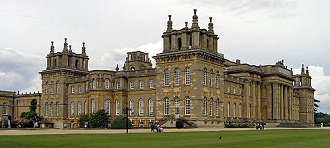

On Aug. 12-13, 1704 after British forces under John Churchill, 1st Duke of Marlborough (1650-1722) march toward the Danube River, meet up with Austrian forces under Prince Eugene of Savoy near Mandelsheim, and together march ulm in ulm to Ulm, they defeat the French under marshals Camille d'Hostun de la Baume, Duc de Tallard (1652-1728) and Ferdinand, Count of Marsin (1656-1706), and the Bavarians under elector Maximilian II Emanuel at the Battle of Blenheim (Second Battle of Hochstadt) (pr. BLEN-im) (corruption of Blindheim) N of Nuremberg on the Danube River in W Bavaria 23 mi. NW of Augsburg, with 4.5K British and Austrians KIA and 7.9K wounded vs. 20K French and Bavarians KIA or wounded and 14K taken POW; the French and Bavarians are beaten so badly that the French attack on Austria is broken, and French prestige suffers from the first pitched battle lost by French troops since who knows when; the giant Allied V ensures the safety of Vienna, preventing the collapse of the Grand Alliance, becoming a turning point in the War of the Spanish Succession; from now on French military domination of Europe begins to tank; Marlborough becomes a big hero back home, and Queen Anne promises to build him his own pretty little palace in Woodstock, Oxfordshire, called Blenheim Palace (1705-22), designed by Sir John Vanbrugh (1664-1726) and Nicholas Hawksmoor (1661-1736), becoming the only non-royal non-episcopal country house in England with the title of palace; too bad, political infighting leads to the duke of Marlborough's exile, damaging Vanbrugh's rep.; meanwhile Duke Victor Amadeus I of Savoy flip-flops, ditches France and joins Austria, pissing-off the French and causing them to send troops under Gen. Vendome to trash the Piedmont; the Rakoczy uprising in Hungary is robbed of its promised help by the French and Bavarians, causing him to mint new copper coins to replace silver coins as the economy collapses.
On Feb. 15, 1723 Louis XV of France attains majority, and puts Dr. Evil, er, regent (since 1715) Duke Philippe II of Orleans (b. 1674) out of business just in time, since he croaks on Dec. 23 after becoming PM - a little arsenic?


On Jan. 5, 1757 (4:00 p.m.) Robert-Francois Damiens (b. 1715) attempts the life of Louis XV by sticking a knife in his chest, which turns out to only be a flesh wound; Jacques Casanova arrives in Paris minutes afterwards?; despite not committing regicide, Damiens becomes the last person in France to be executed by drawing and quartering in a hideous drawn-out fun-in-the-sun day at the Place de Greve, attempting to ape the 1610 execution for Henry IV's assassin. Watch video.
In Apr. 1757 two French armies invade Germany to draw Prussian forces invading in four columns under Frederick II the Great away from the Bohemian theater; on May 1 Austria and France
sign an offensive treaty against Prussia; on May 6 Frederick II's 67K Prussians defeat 64K Austrians under Charles of Lorraine at the
Battle of Prague (Sterboholy) with 10K casualties on each side, then siege Prague until a relief army led by field marshal
Leopold Josef, Count von Daun (Dhaun) (1705-66)
defeats him for the first time in his Great Life on June 18 at the desperation-time Battle of Kolin,
forcing him to leave Bohemia; Austrian empress Maria Theresa is so happy at the V that she institues a military order bearing her name, and names Daun for its first grand cross.
On June 13 scholarly Pope (since 1740) Benedict XIV issues a decree on the unwonderful Roman Catholic Index of Prohibited Works, finally permitting readings of vernacular
versions of the Bible "approved by the Holy See and published under the direction of bishops", and annulling the infamous anti-Copernican decree of 1616; Antonio Martini,
later archbishop of Florence begins to trans. the Vulgate into Italian, and pub. it in 1769-81.

On Aug. 9, 1757 French Gen. Louis-Joseph, Marquis de Montcalm (1712-59), CIC of French forces in North Am. captures Ft. William Henry on Lake George (Lac Sainte Sacrament) in Upstate N.Y., commanded by Irish-born Lt. Col. George Monro (1700-57) (while Monro's daughter Cora's loverboy Hawkeye is held in chains awaiting execution and Magua plans a bloodthirsty revenge on White-Hair?); the returning British soldiers are viciously ambushed and massacred by the Abenaki (Abnaki) (allies of the French), and the incident becomes notorious as a French violation of the internat. laws of war.

On Aug. 18, 1765 HRE (since Sept. 13, 1745) Francis I (b. 1708) dies at the Innsbruck wedding of his son Joseph II (1741-90) (one of 16 children of Empress Maria Theresa), who becomes HRE (until Feb. 20, 1790), the first of the House of Hapsburg-Lorraine; he is controlled by his mother, who acts as co-regent, uttering the soundbyte "I'd personally lead my troops into battle if I wasn't always pregnant".
In 1766 Stanislas Leszczynski (b. 1677) dies, and the Duchy of Lorraine in NE France (founded in 959) is incorporated into France as a province, with Nancy remaining as its capital - double-crossed?

Do you know the way to Hot Air Bay? On June 4, 1783 the French papermaker Montgolfier Brothers incl. Joseph-Michel Montgolfier (1740-1810) and Jacques-Etienne (Étienne) Montgolfier (1745-99) of Annonay (near Lyons), France test their first small unmanned smoke-filled paper-lined linen hot air balloon, which rises to a height of 3K ft. at Annonay, France in a 10-min. 1-mi. flight; on Aug. 27 Parisian physicist Jacques Alexandre Cesar (César) Charles (1746-1823) launches a 13-ft.-dia. silk balloon (constructed under his supervision by A.J. and M.N. Robert) filled with hydrogen in Paris in front of 50K spectators; it floats at 3K ft. for more than 45 min. and lands in a village 16 mi. away, where the spooked villagers attack it with stones and knives; on Sept. 19 the Montgolfier Brothers conduct another demo in Versailles, witnessed by Louis XVI and Marie Antoinette, where a duck, rooster, and sheep become the first living passengers, traveling 2 mi. in 8 min., with max. alt. of 1.5K ft, pissing-off the king with the dense smoke they deliberately generate in the belief that it's what causes the buoyancy, later learning that it's heat; on Oct. 15 French daredevil physician Jean Francois Pilatre de Rozier (1754-85) makes the first tethered balloon ascension, repeating the demo on Oct. 17 before a group of scientists, then reaching 324 ft. on Oct. 19; on Nov. 21 (2 p.m.) champagne-toting de Rozier and army officer Marquis Francois Laurent le Vieux d'Arlandes (1742-1809) make the first untethered human flight, reaching a peak alt. of 500 ft. and traveling 5.5 mi. in 25 min. from the Bois de Boulogne in Paris in the presence of Louis XVI and a huge crowd, across the Seine River to the Butte-aux-Cailles; the next day Benjamin Franklin et al. sign the official certification at Passy; on Nov. 31 Jacques Charles (financed by Franklin) flies in his hydrogen balloon, while gouty Franklin watches from his carriage near the Tuileries Gardens; balloon exhibition flights soon become the rage in Paris; when asked what was the practical use of these balloon thingies, Franklin replies "What is the use of a newborn baby?"; the power of a mere individual to go over the king's head and attract large crowds is a giant leap for popular democracy, making the French Rev. inevitable, and, combined with the success of the U.S., it coulda gone better if only they hadn't dabbled with the powder keg of godless atheism?





Just a little bit, just a little bit, sock it to me sock it to me? On June 17, 1789 after the king's financial adviser Jacques Necker (1732-1804) (wrong name for this country?) rigs the voting by rank to nullify the third estate's advantage, Abbe Emmanuel Joseph Sieyes (Sieyès) (1748-1836), author of of the hit CD What Is the Third Estate? makes a motion, causing it to bolt and meet to form a new constitution, declaring itself the beat-me-heat-me-come-on-eat-me Nat. Assembly, and inviting the other estates to join, which causes king (since May 10, 1774) Louis XVI (1754-93) on June 20 to lock them out and suspend meetings for three days, which doesn't phase them, because they got cat scratch fever and meet in an indoor tennis court, swearing the Tennis Court Oath to stay in session until they create a new constitution; on June 23 the king continues to try to stop them, ordering each estate to meet separately, and Honore (Honoré) Gabriel Riqueti, Comte de Mirabeau (1749-91) (elected for both Marseille and Aix) steps forward and answers royal messenger Henri Evrard, Marquis de Dreux-Breze (Dreux-Brézé) (1762-1829) with the truly breezy immortal Mr. Saturday Night Special soundbyte: "If you have orders to remove us from this hall, you must also get authority to use force, for we shall yield to nothing but to bayonets"; a Great Fear descends, causing the aristocracy to fear a terror by "brigands", which don't actually exist, but their fear causes the peasants to organize armed bands; the 10-year 7-mo. 11-day French Rev. (ends 1799) begins as 24M French citizens kept down by 400K aristocrats upend the entire social structure, infecting the world with incurable dreams of equality that overtake the milder Am. Rev.; on June 27 after the three estates unite, Louis XVI orders the rumps of the first two estates to join them, and Comte de Mirabeau emerges as leader; although Louis XVI is waffling, his wife Marie Antoinette makes him take the hard line, talking him into sending troops from Versailles to surround Paris in an obvious plan to you know what; the aristocratic favorite drink tea becomes unpopular for the next 50 years.

On July 2, 1789 dirty bastard Marquis de Sade (1740-1814), who is imprisoned in the Bastille yells to the crowds outside "They are killing the prisoners here!", causing a riot, after which on July 4 he is transferred to the Charenton insane asylum near Paris, missing out on the July 14 storming of the Bastille, although his estate in Lacoste is sacked by a mob later this year; he is finally released in 1790 after the assembly abolishes the instrument of lettre de cachet that had been used to imprison him sans charges, divorces his wife and hooks up with actress Marie-Constance Quesnet, with whom he spends the rest of his life, growing extremely obese and calling himself "Citizen Sade", getting elected to the Nat. Convention representing the far left despite his aristocratic background.

Catastrophe theorists here's your butterfly flapping its wings and causing a hurricane? On July 12, 1789 reformer French minister Jacques Necker is suddenly fired by the king, and failed French lawyer Camille Desmoulins (1760-94) has his 15 min. of fame when he loses his usual stammer and jumps up on a table on a cafe outside the Palais Royal and utters the immortal soundbyte: "This dismissal is the tocsin of the St. Bartholomew of the patriots!", after which he draws two pistols and declares that if the pigs are going to take him they will have to take some bullets first, triggering riots in Paris, which on July 13 leads to a partisan militia, later becoming the Nat. Guard being formed; Desmoulins is now a celeb, and becomes a writer-journalist, going on to pub. Discours de la Lanterne aux Parisiens, which quotes John 3:20 ("He that does evil hates the light"), causing him to become known as the "Lanterne Prosecutor", going on to pub. the pro-violence Histoire des Revolutions de France et de Brabant (until July 1791), making him rich and famous; meanwhile on July 12 wax heads of Jacques Necker and the Duc d'Orleans made by Dr. Philippe Curtius (1741-94), mentor of Madame Tussaud are carried in a protest march.




Prison break! Prison break! Those pipes are the way out? On July 14, 1789 (Tues.) (Bastille Day) after the prisoners cry to be released, the 14th cent. crenelated Bastille fortress prison in Paris falls after the soldiers refuse to fire on Parisian citizens and they storm it and release all seven prisoners inside (they leave a copy of Nostradamus' "Centuries" open to the Preface on a table for 10 days to allow people to file past and read how their rev. has been predicted?); aided by French Royal Guard deserters they capture and kill Bastille gov. (since 1776) Bernard-Rene (Bernard-René) Jourdan, Marquis de Launay (b. 1740), then shoot and murder Jacques de Flesselles (b. 1721) at the Hotel de Ville, who becomes the last provost of the merchants (mayor) of Paris (since 1785); the king is awakened in the middle of the night by his chamberlain to tell him the potty news, and now that he has lost the support of his army he knows he's kaput, and writes in his diary "Nothing", meaning he didn't go hunting?; on July 15 the electors of Paris abolish the French feudal system and set up a Commune after Louis backs down and orders his troops out of Paris; Marquis de Lafayette becomes cmdr. of the Nat. Guard (originally proposed by Comte de Mirabeau), and bookish painter-tragedian-scientist (expert on the history of Science) Jean-Sylvain Bailly (1736-93) is elected mayor of Paris (until Nov. 1791 1791); on July 17 amid a gen. panic about a "famine plot" by the aristocrats (15%) to starve or burn-out the rest of the pop., causing peasants and townfolk to unite and mobilize, the king recalls Necker; the French Tricolor Flag is adopted, white for France, blue and red for Paris; on July 20 peasants arise throughout France, beginning the Grande Peur (Fr. "great fear"), which ends on the night of Aug. 4 with the nobles and clergy surrendering their feudal rights and privileges, ending feudalism in France and kicking the manorial lords out of Dauphine, Provence, Burgundy, et al.; Burgundy, a province since 1678 is split up into the depts. of Ain, Cote d'Or, Saone-et-Loire and Yonne; the smarter French nobles begin skedaddling from France in the Emigration of the Nobles - it's time to get outside and grow something?

On Nov. 1, 1790 Irish philosopher and British Whig MP (1766-94) Edmund Burke (1729-97) pub. Reflections on the Revolution in France; alt. title: Feudalism Rocks?; founds the philosophy of modern conservatism; written in response to radical Protestant dissenter Richard Price and other French Rev. supporters, questioning it from a reactionary POV, supporting religious institutions as moral stabilizers of society; predicts that the French Rev. will go corrupt and violent, ending in a military dictatorship, becoming a favorite of George III and Joseph de Maistre; condemns the French Rev. persecution of the Roman Catholic Church, causing accusations of being a secret Catholic; when Charles James Fox becomes practically the only MP to support the French Rev., he loses Burke's friendship, becoming leader of the New Whigs, while Burke leads the Old Whigs; British Romantic poets Blake, Byron, Coleridge, Keats, and Shelly support the French Rev.; replies incl. "A Vindication of the Rights of Men" (1790) by Mary Wollstonecraft, and "Rights of Man" (1791) by Thomas Paine; "As literature, as political theory, as anything but history, his Reflections is magnificent" (Alfred Cobban); "All circumstances taken together, the French revolution is the most astonishing that has hitherto happened in the world. The most wonderful things are brought about in many instances by means the most absurd and ridiculous; in the most ridiculous modes; and apparently, by the most contemptible instruments. Every thing seems out of nature in this strange chaos of levity and ferocity, and of all sorts of crimes jumbled together with all sorts of follies"; "The age of chivalry is dead, that of sophisters, economists and calculators has succeeded, and the glory of Europe is extinguished forever."
In 1790 the Dual Rev. (economic and political) (ends 1848) begins in England and France, leading to the 19th cent. becoming a powder keg of people on the make and on the take?
On Aug. 27, 1791 the Declaration of Pillnitz (Pilnite) is signed at Pillnitz Castle near Dresden by Frederick William II of Prussia and HRE Leopold II of Austria (brother of Marie Antoinette), promising to intervene in French affairs to restore Louis XVI, but only with the unanimous consent of the other powers incl. Britain; instead of stopping the French Rev., it helps trigger it a few weeks after Leopold II's death?


Welcome to the next round? A classic case of what goes around comes around? The pen is mightiless against the sword? On Mar. 20-25, 1792 the Legislative Assembly in Paris sticks its neck out and approves the use of the centuries-old "painless" Guillotine, named after physician (Freemason) Joseph-Ignace Guillotin (1738-1814), who recommends it as a humane form of execution, as well as a way of eliminating the class distinction of hanging commoners while beheading nobles, who are expected to go to their deaths without displaying emotions unless they're women; on Apr. 4 the first guillotine is installed in the Place de Greve in Paris; on Apr. 25 highwayman Jacques Nicolas Pelletier becomes the first person executed by the new "feminine" form of execution; in Aug. a giant guillotine is erected in the Place de Carrousel in the center of Paris, whose blade makes a noise like thunder when it falls, designed by German harpsichord maker Tobias Schmidt, who was working with Metz-born king's surgeon Antoine Louis (1723-92) (secy. of the surgical academy), and main executioner (since 1754) Charles Henri Sanson (1739-1806) (4th hereditary executioner in the family since 1688); Schmidt turns the blade o a 45-deg. angle and changes it from round to you know what, and it is weighted by a pulley system as it travels down two 14-ft. upright greased wooden planks, all of which are reached by a 24-step platform; in 1890 asst. executioner Leon Burger adds refinements; the machine is set up also at the Place de la Revolution, Place St. Antoine, and Barriere (Barrière) Ranverse; it is originally called "La Veuve" (window), and after Louis XVI's execution "La Louison", then after Marie Antoinett'e execution "La Louisette", and not called guillotine until after 1800; 15K heads roll by 1799, out of 40K total killed during the Terror, 70%-80% of them commoners; tricoteuses sometimes sit near the base of the scaffold knitting stockings for soldiers - well, shiver me carotids?
On Apr. 20, 1792 after getting pissed-off by the 1791 Declaration of Pillnitz and issuing ultimatums against HRE Leopold II and Francis II, France declares war on the HRE (Austria), which lasts 23 years (until 1815) and results in 1.5M French KIA; the First Coalition against France is formed.

On Apr. 25, 1792 French army officer (capt. of engineers at Strasbourg) Claude Joseph Rouget de Lisle (1760-1836) composes the French nat. anthem (adopted in 1795) La Marseillaise (Song of Marseille) (originally "War Song of the Army of the Rhine") (Chant de guerre pour l'Armée du Rhin) (dedicated to Bavarian-born French marshal Nicolas Luckner), which is sung at a patriotic meeting in Marseille by Francois Mireur (1770-98) and catches on, being sung in the streets of Paris upon arrival by volunteers from Marseille then spreading to the rest of the French army; it is adopted as the French nat. anthem on July 14, 1795; after they occupy the town of Carmagnola in Piedmont, Italy, French revolutionaries begin wearing their costume, the Carmagnole, a short jacket with wide lapels, worn with black trousers instead of knee breeches, earning them the name "sans-culottes", meaning without breeches, along with a red cap and tricolored girdle; "La Marseillaise" is first sung on July 30 in Paris.
In May 1792 an aide-de-camp to Col. Marquis de Toulengeon deserts, and his daddy the Marquis de Sade, who was elected to the Nat. Convention in 1790 representing the far left, where he wrote a pamphlet calling for the direct vote is forced to disavow him to save his neck; next year he writes a eulogy of Jean-Paul Marat to save his job, but is accused of moderatism, forced to resign, and imprisoned, after which he is released after the July 28, 1794 execution of Maximilian Robespierre, and becomes a penniless bum, selling his ruined castle in Lacoste in 1796, which in the 1990s is purchased by French fashion designer Pierre Cardin for theater festivals.
In July 1792 Comte de Rochambeau, cmdr. of the French Rev. Northern Army freaks at the excesses and retires in disgust, and ends up imprisoned during the Reign of Terror, escaping the guillotine by the fall of Robespierre in 1794, being released and restored by Napoleon to his rank and estates.

On Aug. 10, 1792 popular demonstrations lead to the storming of the Tuileries Palace, the royal residence on the right bank of the Seine River in Paris, and the royal Swiss Guard (created 1616) shows their loyalty by defending it, losing 800 KIA; all functions of the monarchy are suspended, and not only is the king's veto power quashed, but the Nat. Legislature votes to enact all legislation he previously vetoed, and calls for a convention elected by universal male suffrage to enact a new constitution; the poor royal family is confined to tower of the the gloomy Square du Temple (old Knights Templar house) in Paris; La Carmagnole, a song written after the storming of the Tuileries, consisting of 13 2-line stanzas ridiculing the king and queen becomes popular until the end of the Terror in 1794; "Dansons la carmagnole,/ Vive le son, vive le son;/ Dansons la carmagnole,/ Vive le son du canon".
On Aug. 11, 1792 as the allies score big Vs against the French revolutionaries, the 9 (later 12) man Jacobin Provisional Executive Council (Committee of Public Safety) under Danton, Robespierre, Saint-Just, et al., and the male suffrage-based Paris Commune under Jacques Rene Hebert (René Hébert) (1757-94) (founder of the ultra-radical newspaper "La Pere Duchesne"), Pierre Gaspard Chaumette (1763-94) and Jean Baptiste du Val-de-Grace, Baron de Cloots (1755-94) (AKA Anacharsis Cloots) seize power.
On Aug. 20, 1792 the Battle of Verdun is a V for the Prussians over French Rev. forces, after which the 12 Virgins of Verdun carry a basket of sugared almonds to the Prussian king's tent (they are later guillotined); on Sept. 2-7 news of it causes the September Massacres to take place in Paris, in which 1.2K-1.4K suspects taken from prisons are tried in improvised tribunals and then executed; the riots spread to Versailles, Lyons, Rheims, Meaux, and Orleans, and anarchy threatens, while cries for the king's head increase.
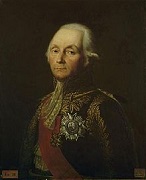
On Sept. 20, 1792 a French Repub. army under Lt. Gen. Francois Christophe Kellermann (1735-1820) (gen. of the army of Alsace since 1791) finally defeats the Prussians under the Duke of Brunswick, the Prince of Hohenlohe, and the Count of Clerfayt at the Battle of Valmy in N France, giving them their first V, which Goethe claims "opened a new era in the history of the world", making Kellermann a star, with Napoleon uttering the soundbyte: "I think I'm the boldest general that ever lived, but I daren't take post on that ridge with windmill at Valmy"; too bad, after being transferred to the army of the Moselle River, Kellermann is accused of Gen. Adam Custine of incompetence, but is acquitted at the Nat. Convention in Paris and given the army of the Alps and Italy, until he is ordered to stop a revolt in Lyons, and is accused again and imprisoned for 13 mo. before being acquitted and assigned to the SE border until his army is merged with Napoleon's in Italy, with big fan Napoleon getting him named senator in 1800, pres. of the senate in 1801, marshal of France on May 19, 1804, and created duke of Valmy in 1808; in 1814 he votes to depose Napoleon, and becomes a liberal member of the Chamber of Peers until Louis XVIII. Louis Philippe Joseph, Duc de Chartres (Valois) (1773-1850) (later Duc de Orleans), who joined the Jacobins in 1790 fights at Valmy as a lt. gen., and later at Jemappes.
On Sept. 20, 1792 the French Nat. Legislature orders the state to take over the recording of marriages, births and deaths from the Church, and legalizes divorce.
On Sept. 21, 1792 the French Nat. Convention convenes (until Aug. 22, 1795), elected by universal male suffrage and composed of 749 members (486 new), with the Plain Party in the majority, the Girondists on the right, and the Mountain Party (Danton, Robespierre et al.) on the left; it immediately votes to abolish the monarchy (making the king and queen ordinary citizens) and suspend the legislative assembly; the hated gabelle (salt tax) (begun 1341) is abolished (until 1804); nobles kiss their titles goodbye, and become "ci-devant" (heretofore) nobles.
On Sept. 22, 1792 the First French Repub. is declared, with the calendar reset to Year 1 (ends 1804); on Sept. 25 the repub. is declared "one and indivisible".
On Oct. 2, 1792 the Committee of Gen. Security is formed in France, with undefined police powers - Halloween 1-999 music here?
On Nov. 2-Dec. 5, 1792 the 1792 U.S. pres. election sees George Washington and John Adams are reelected unanimously; too bad, the unanimous stuff ends as Thomas Jefferson founds the Democratic-Republican Party (later the Democratic Party) as a congressional caucus to fight against the Federalist Party, formed in 1789 by Alexander Hamilton, launching the First Party System (ends 1824), with the Federalists becoming dominant until 1800; on Feb. 12, 1798 Thomas Jefferson writes the soundbyte: "Two political Sects have arisen within the U. S. the one believing that the executive is the branch of our government which the most needs support; the other that like the analogous branch in the English Government, it is already too strong for the republican parts of the Constitution; and therefore in equivocal cases they incline to the legislative powers: the former of these are called federalists, sometimes aristocrats or monocrats, and sometimes Tories, after the corresponding sect in the English Government of exactly the same definition: the latter are stiled republicans, Whigs, jacobins, anarchists, dis-organizers, etc. these terms are in familiar use with most persons."
On Nov. 6, 1792 45K French under Gen. Charles Francois du Perier (Périer) Dumouriez (1739-1823) defeat 13K Austrians in their winter HQ in the Battle of Jemappes in SW Belgium, causing them to retreat, after which the French capture Brussels.
On Nov. 19, 1792 the Decree of Fraternity offers French aid to people wishing to overthrow their govts., causing the English govt. to get antsy, while Irish nationalists take them up on their offer. On Dec. 4 the French Nat. Convention declares the death penalty for advocating monarchy; on Dec. 8 it repeals its suspension on free trade in grain but outlaws exports; in the Beauce region prices are fixed, causing peasant demonstrations. On Dec. 10 Louis XVI goes before the Nat. Convention to face neckable charges of treason, and on Dec. 11 is presented with incriminating letters from his iron cupboard, claiming to have never seen them and denying his own signature, causing the Jacobins to decide he's guilty; on Dec. 27 the Girondists (moderate republicans) propose a referendum of the people to decide - the original American Idol?
In 1792 Marquis de Lafayette is given command of the French Rev. Army of the Center, becomes disgusted by the excesses of the French Rev. and bolts for Belgium, where he is captured by the Austrians and imprisoned for five years.
In 1792 Gouverneur Morris, who has been in Paris since 1789 and kept a Diary of the French Rev., 1789-93 becomes U.S. minister to France (until 1794).
In 1792 the new French govt. seizes Hospitaller property in France; the Sorbonne in Paris is suppressed and its property confiscated (until 1808); the Hope Diamond, owned by Louis XVI vanishes during the turmoil in Paris, and doesn't resurface for almost 40 years - who had to die?

In 1792 French military surgeon Dominique Jean Larrey (1766-1842) joins the Army of the Rhine, inventing Flying Ambulances after seeing French Flying Artillery, and combining them with the first MASH units complete with triage; after becoming a favorite of Napoleon and becoming a baron in 1809, he leads the surgical team that performs a mastectomy on English writer Frances "Fanny" Burney in Paris on Sept. 30, 1811; in 1810 he becomes one of the first surgeons to operate on the pericardial sac.

In 1792 French navigator Antoine Raymond Joseph de Bruni d'Entrecasteaux (1739-)93 of France begins a rescue expedition for La Perouse (disappeared 1788), visiting many Pacific islands and exploring New Caledonia (until 1793); he discovers the D'Entrecasteaux Islands SE of New Guinea, incl. Ferguson, Goodenough and Normanby, inhabited by Papuans.

I'm walking on sunshine, whoa-oh? On July 15, 1801 the Concordat of 1801 (announced on Easter Sunday, 1802), signed in Paris by Napoleon and Pope Pius VII reconciles the French Consulate with the Roman Catholic Church, and reestablishes and governs the relations of the French Church with Rome for the next cent., esp. by recognizing Protestantism (both Lutheran and Calvinistic), Judaism, and Roman Catholicism as established religions entitled to state support and subject to state control; the consul appoints bishops, subject to confirmation by the pope, and the bishops choose their own clergy, paid by the govt.; the pope continues to control the Papal States, except Ferrara, Bologna, and Romagna; priests in Belgium and other outlying regions form the Petite Eglise (Little Church) outside Courlay in Deux-Sevres to oppose it, functioning without a priest; Joseph Fesch (1763-1839), half-uncle of Napoleon I is made archbishop of Lyons for helping bring the concordat about, and cardinal next year.


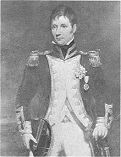
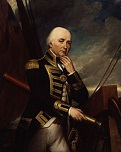
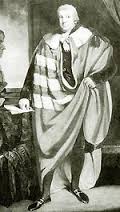
Hands across the water, hands across the sky, or, Bloody Trick or Treat, What What? England gets its world-class naval hero? On Oct. 21, 1805 (Mon.) after the French fleet under vice-adm. Pierre Charles Jean Baptiste Silvestre de Villeneuve (1763-1806) breaks out of Toulon and eludes the British fleet under vice-adm. Horatio Nelson, 1st Viscount Nelson, 1st Duke of Bronte (b. 1758), then takes refuge in Cadiz and receives reinforcements from the Spanish navy, bringing them up to 33 ships (vs. 27 for the British), and slowpoke Nelson catches up and blockades it, the French break out of the harbor again, beginning the naval Battle of (Cape) Trafalgar (Britain's greatest sea battle?) between Gibraltar and Cape Roche outside Cadiz, resulting in a decisive V for the British, dashing Napoleon's hopes of invading England and establishing British sea supremacy for the next 150 years; Adm. Nelson, aboard his flagship HMS Victory leads the charge that breaks through the center of the French line between Bucentaure and Redoubtable, capturing 10 French and 11 Spanish ships, with no British ships lost, and a total of 1,666 British casualties (458 KIA and 1,208 wounded) vs. 13,781 French-Spanish casualties, incl. 3K POWs drowned in a storm after the battle; Victory suffers 57 KIA and 102 wounded, with Redoutable attempting to board her but suffering a devastating broadside from the 98-gun HMS Temeraire, commanded by Adm. Sir Eliab Harvey (1758-1830), known for recklessly gambling his family fortune in London, who also forces the surrender of the Fougueux, causing him to create the family motto "Redoubtable and Fougueux"; Nelson signals the famous message "England expects that every man will do his duty", and is wounded several times by French sharpshooters before meeting his death as the battle ends from a musket ball from Redoubtable that enters his left shoulder and lodges in his spine, dying at 4:30 p.m. and giving a last order to anchor the fleet, which is countermanded by his 2nd in command vice-adm. of the blue Cuthbert Collingwood (1748-1810), who succeeds Nelson as CIC, transferring his flag from the damaged Royal Sovereign to the Euryalus, attempting to tow damaged vessels until a storm wrecks many prizes incl. Redoubtable on the rocky shore while others are destroyed to prevent capture, getting Collingwood a promotion on Nov. 9 to vice-adm. of the red along with a peerage as Baron Collingwood of Northumberland, along with a £2K/year pension and his 3rd gold medal from Parliament (joining Nelson and Sir Edward Berry); Victory is towed by HMS Neptune to Gibraltar for repairs, then flies a black sail on its return voyage to England; Villenueve is captured by the English, and returned to France next year; in Nov. Adm. Horatio Nelson's elder brother William Nelson (1757-1835) is created 1st Earl Nelson of Trafalgar; Portugal restores relations with its old ally Britain, causing France to declare the 1801 Treaty of Badajoz cancelled, leading to the 1807-10 Peninsular War.


On Oct. 31, 1808 after a 23K-man Spanish (Galician) army under Irish-born gen. Joachim (Joaquin) Blake y Joyes (1759-1827) advance E of Bilbao to cut the French lines of communication back to Bayonne, the Battle of Zornoza (Pancorbo) is a V for the 22K-man French army under Marshal Claude Victor-Perrin, 1st Duke of Belluno (1764-1841), and Marshal Francois Joseph Lefebvre, 1st Duke of Dantzig (1755-182) with 1.2K French vs. 3K Spanish casualties, after which Blake leads his army in a heroic retreat W through the mountains, chased all the way by Marshal Soult, arriving in Leon on Nov. 23 with only 10K left, pissing off Napoleon I.


On Mar. 20-July 8, 1815 the Hundred Days (War of the Seventh Coalition) (really 111 days) culminates in Emperor Napoleon I (1769-1821) meeting British gen. Arthur Wellesley, Duke of Wellington (1769-1852) for the last time at Waterloo, which Wellington later claims "was won on the playing fields of Eton"; on Feb. 26 after getting pissed-off at the Bourbon restoration and the machinations of the Congress of Vienna, and seeing his chance with Anglo-Dutch troops under Wellington and Prussian troops under Blucher scattered around the Low Countries, Napoleon eludes British patrol ships and escapes Elba, then lands on Mar. 1 in Cannes, where troops sent to capture him fall prey to his charisma and and rally around him, causing Louis XVIII to flee to Ghent; on Mar. 13 the allies issue a ban against Nappy, but that doesn't stop him from entering Paris and establishing a govt., with the Duc de Cambaceres as pres. of the House of Peers and minister of justice, then organizing an army to reconquer Belgium and Holland, causing Austria, Britain, Prussia, and Russia to form the Seventh (Final) Coalition against him on Mar. 25, supplying 180K men each and getting all European nations except Sweden to join, resulting in a 1M-man army; Pierre Samuel du Pont de Nemours takes the cue and returns to the U.S. with his sons; Nathan Mayer Rothschild funds the Brits, while Jacob Rothschild funds the French, allowing them to play both sides and end up owning a large amount of the British Empire, after which they force their five C European banks to be used instead of transferring precious metals from country to country? The orchestra is on their feet? The last half of the year is a big gig for the European diplomats, who carve up France's carcass for their royal absolutist masters?
On June 9, 1815 the Congress of Vienna (begun 1814) closes with the Treaty of Vienna; the result is the concept of the balance of power to preserve internat. equilibrium of the winning powers, with periodic congresses meeting to maintain peace (prevent revolts); France reverts to its 1790 boundaries, but is allowed to keep Avignon, which it took from the papacy; Russia keeps Finland, and the greater part of the Grand Duchy of Warsaw, which is dissolved, and Poland (Cracow) is repartitioned between Russia, Prussia and Austria, with a kingdom of Poland created under a king and the Russian tsar, with the right to have unspellable Polish as the official language plus their own army (ends 1846); Austria emerges as the dominant power on the continent (ends 1866), receiving new territories in Italy and the Illyrian Provinces; Prussia receives part of the duchy of Warsaw, Danzig, Swedish Pomernia and Rugen, plus new parts of Westphalia and Neuchatel and more than half of Saxony, which becomes a province; on Aug. 24, 1815 the Fundamental Law of the Kingdom of the United Netherlands is passed, uniting Belgium and Holland in an uneasy religious-unfriendly alliance in order to create a strong buffer state against France (ends 1830); Luxembourg (founded 963), the 350-year toy of Burgundy, Spain, Austria and France is made a Grand Duchy and given to the Netherlands; Switzerland becomes independent of France, and on Nov. 20 the Swiss Federal Pact is ratified, creating a confederation of 22 contiguous autonomous cantons with a Diet with restricted powers which requires the vote of two-thirds of the cantons to ratify any act; Norway and Sweden are joined in another bad marriage under one ruler; the dynasties in Spain, Sardinia and the Papal States (incl. Bologna) which had been taken over by the Napoleon clan are restored; the Valtellina passes to the new Lombard-Venetian Kingdom held by Austria (until 1848); Piedmont is returned to the kingdom of Sardinia, which is given Genoa and Liguria, making it the #1 independent state in the Italian peninsula; the new Germanic Confederation is formed (until 1848, then 1850-66), consisting of 38 member states (Austria, Liechtenstein, Hamburg et al.) as the replacement for the Holy Roman Empire (ends 1866), with a Diet at Frankfurt-am-Main consisting of two assemblies of diplomats presided over by Austrian reps.; the Ionian Islands of Greece are taken from France and placed under British suzerainty (until 1863); East Friesland is added to Hanover (an electorate since 1692), which is proclaimed a kingdom (until 1886), and restored to the English crown (ends 1837); England gains the nice naval hops of Malta and Helgoland, the Cape of Good Hope, and scattered island possessions taken from the Netherlands and France; Switzerland promises to not allow their famous and feared mercenaries to fight anywhere but at home and the Vatican; brie is declared the king of cheeses; the war to end all wars is over, but the real war is on hotter than ever between the liberal forces seeking to end absolutism in a hedonistic world that delights in pleasure and sin, and the absolutist forces seeking to hold onto their gains and the religious piety of the masses while themselves delighting in, er, pleasure and sin, with round one being conservative top dog Austria vs. liberal-hope challenger Prussia, whose liberal pop. has the problem of the Junkers (large landholders); after a cent. of strife it takes WWI to finally undo the old order completely?







Into each life some rain must fall? On June 15-16, 1815 Napoleon suddenly crosses the Belgian frontier and attacks Charleroi, taking it from the Prussians; on June 16 he severely defeats Field Marshal Blucher at the Battle of Ligny (Nappy's last V), forcing him to fall back, while he personally rallies his scattered troops; meanwhile French marshal Michel Ney attacks the British under the Prince of Orange at the June 16 Battle of Quatre Bras and is defeated, while French troops under marshal Jean-Baptiste Droute, Count d'Erlon (1765-1844) are given conflicting orders and march back and forth between Ligny and Quatre Bras without engaging; Napoleon orders cavalry cmdr. marshal Emmanuel de Grouchy, 2nd Marquis de Grouchy (1766-1847) to follow and attack Blucher and his Prussians, who are expected to retreat S to Namur, but his orders are delayed for 12 hours, and Grouchy doesn't follow them, blindsiding grouchy Nappy, who joins Ney on June 17 and follows the retreating British on the road to Brussels, having a perfect life until they make a stand at the crossroads of Mt. St. Jean in front of the village of (what's love? that's right?) Waterloo; the last major battle involving all the great powers of Europe until 1914; alas, if only there had not been a bad rainstorm on the 17th, and he had not been suffering from painful hemorrhoids keeping him inside his tent high on opium, Nappy might have taken the unready Brits, but c'est la vie?; on June 18 (Sun.) (midday) (6, 6+6+6, 1815 = 6+6+6 + 1+5=6?) the watershed Battle of Waterloo in Belgium between Napoleon and the Duke of Wellington's 32K troops begins with a French frontal attack on Wellington's troops at the Battle of La Haye Sainte (named after a farmhouse at the E end of the battlefield that is named after Jesus Christ's crown of thorns) whose "thin red line" repels the French cavalry charge three, count 'em, three times, giving Blucher's troops (who had not fallen back to Namur, but turned N along a series of farm roads to Wavre, eluding grouchy Grouchy) under new cmdr. August Wilhelm Antonius Graf Neidhardt von Gneisenau (1760-1831) (who took charge after aging Field Marshal Blucher became disabled at Ligny) to surprise know-it-all-Nappy (the original Wrath of Khan vs. Kirk and Spock?), and come into view, though they are slowed by the muddy conditions, and take until 4:30 p.m. to reach the French at Planchenoit, on Nappy's right flank, getting him into a vise; at 7 p.m. the decision hour arrives, and Nappy the Gambler risks his Old (Imperial) Guard, who fight to the last man in vain, until finally the Frogs are routed; the French propose a truce, which is laughed off, and Gneisenau pursues the Frogs to the gates of Paris, capturing Napoleon's carriage, and beating Wellington; on July 7 Paris is retaken, and Louis XVIII returns to his throney throne throne, backed by large sums of money raised by Jacques Laffitte (1767-1844), who becomes gov. of the Bank of France and pres. of the chamber of commerce, supplying 2M francs from his own pocket to cover the pay of the imperial troops after the Battle of Waterloo (Napoleon I himself deposited 5M francs in gold with him before leaving France for the last time); the British Army begin wearing bearskin hats after the Battle of Waterloo to mock Napoleon's Imperial Guard. His last days as a Playboy Playmate coming up in minutes, or, Shrek the Third is about to debut? On June 22 (4 days after the Big D at Waterloo) after going with his brother Joseph Bonaparte to Rochefort, planning to sail separately for N. Am., and Joseph offering to give up his own hired vessel for him, whereupon he graciously lets him escape instead, Napoleon surrenders to British Vice-adm. Sir Henry Hotham (1777-1833) (ham jokes here?), then on July 15 formally surrenders aboard the HMS Bellerophon (Capt. Frederick Lewis Maitland) off Rochefort, and abdicates again in favor of his son Napoleon II (1811-32), who never rules; Napoleon is unanimously ordered by the allies to be exiled to St. Helena Island in the butthole of the Atlantic off the W African coast, where he arrives in the Bellerophon in Oct., and remains until his death on May 5, 1821; the Brits set up a garrison on Ascension Island to the NW, calling it stone frigate HMS Ascension, classified as "sloop of war of the smaller class"; French marshal Michel Ney (b. 1769)is executed for treason on Dec. 7; Gen. Grouchy, who lives in Chateau de la Villette NW of Paris is exiled to Philadelphia, Penn.; Blucher retires to private life and receives a special Iron Cross from pleased-as-punch Frederick William III; the name Arthur (as in Arthur Wellesley, Duke of Wellington) suddenly becomes fashionable for baby boys; the Waterloo Teeth collected from the dead soldiers (most from young boys) for making dentures are so excellent that they are in great demand; Nappy's uncle Cardinal Joseph Fesch is exiled to Rome, bequeathing many art objects to Lyons; Nappy's brother Joseph-Napoleon Bonaparte (1768-1844) flees to Bordentown, N.J. (until 1841), settling down in Point Breeze, N.J. under the title of Comte de Survilliers and going into agriculture - yep, that's me?
On May 5, 1821 Napoleon Bonaparte (b. 1769) dies in exile on St. Helena Island, some say of arsenic poisoning, others of stomach cancer, like his daddy Carlo (1746-85); the last word on his lips is "Josephine"; his body is not released by the British to the French until May 25; he is buried under a weeping willow, and is later interred in a crypt at the Hotel des Invalides in Paris, his tomb decorated with 12 Personified Victories by Swiss-born French sculptor James (Jean-Jacques) Pradier (1790-1852); the city of New Orleans, La. proudly houses his death mask; the Memoirs of Napoleon Bonaparte become very popular in France and Europe; a postmortem by Australian surgeon Charles MacLaurin (1872-1925) finds that "his reproductive organs were small and apparently atrophied. He is said to have been impotent for some time before he died"; a priest obtains his 1 in. penis, and it turns up in 1971 at a Christie's auction in London, but there are no takers; in 1977 a U.S. urologist buys it for $3.8K - guess what I got, baby?


On May 6, 2007 the pres. election in France sees conservative pro-Israel law and order interior minister Nicolas "Sarko the American" Sarkozy (Nicolas Paul Stéphane Sarközy de Nagy-Bocsa) (1955-) ("an American with a French passport") (son of a Protestant Hungarian immigrant and a half-Greek Jewish half-French Roman Catholic mother) of the center-right UMP defeat Socialist Segolene (Ségolène) Royal (1953-) by 53.1% to 46.9%, becoming pres. of France on May 16 (until May 15, 2012), pledging to break the old outmoded habits of France, incl. the 35-hour "absurd" workweek, and to stand up against tyranny, dictators, and Muslim oppression of women, then urges the U.S. to take the lead on fighting global warming; after Sarkozy signals that he will take a tougher line toward Russia, pres. Vladimir Putin fails to congratulate him on his win; meanwhile anti-Sarkozy protests are held in Paris and Marseille, comparing him to Mussolini and Hitler; on May 17 Francois Fillon (1954-) of the UMP is appointed by Sarkozy as PM of France (until May 10, 2012); on June 17 elections give the UMP a clear parliamentary majority, although it's no landslide V as voters fear giving him too much power. On Oct. 18 the biggest strike in 12 years cripples France's public transport system; the same day French pres. Nicolas Sarkozy announces his divorce from wife Cecilia Ciganer-Albéniz (1957-) after 11 years (1996), becoming a first for a French pres.
On Apr. 15, 2019 (18:20 CEST) 850-y.-o. Notre Dame Cathedral in Paris partially burns down over 15 hours, taking the spire and the roof but leaving the stone foundation standing, along with the N belfry tower of "Hunchback of Notre Dame" fame; shocking France and the Roman Catholic world; the cause is not reported until ?; no mention in the PC press that Muslims have been desecrating churches all over France?
On Dec. 25, 2019 Notre Dame Cathedral in Paris misses its Christmas mass for the first time since the French Rev. in 1789.
On Oct. 16, 2020 social studies schoolteacher Samuel Paty (b. 1973) is beheaded in Conflans-Sainte-Honorine SW of Paris by an 18-y.-o. Chechen-born Muslim immigrant for displaying the Charlie Hebdo Muhammad cartoons in class, sparking "I am Samuel" rallies across France; police shoot and kill the suspect, after which French pres. Emmanuel Macron calls it Islamic terrorism, and the French govt. announces the expulsion of 231 "radicalized foreigners".
On Oct. 29, 2020 (a.m.) an Allah-Akbar-shouting 21-y.-o. Tunisian Muslim recent illegal immigrant man stages a knife attack at the Notre Dame Basilica in Nice, France, killing three and injuring several before being killed by police; a woman was almost completely beheaded; hours later police shoot and kill another Allah-Akbar gunman in Avignon, while a knife-wielding Muslim is arrested outside the French consulate in Saudi Arabia after stabbing a guard; more reprisals against Paty?; French pres. Emmanuel Macron declares that France is "under attack" by Islamic terrorists, saying that France "won't surrender anything", increasing deployments to schools and religious sites in France from 3K to 7K.
On Mar. 1, 2021 former French pres. (2007-12) Nicolas Sarkozy is convicted of corruption and influence peddling and sentenced to one year in prison plus a 2-year suspended sentence.